Editors Choice
Review: Panasonic Viera TH-P50S60D Plasma TV
Entry-level plasma with flagship-killing performance.
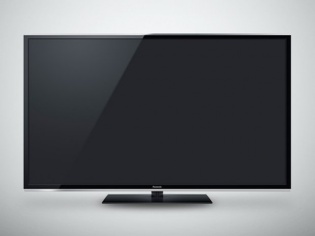
Phenomenal picture quality; Excellent blacks; Accurate colours; No motion blur; Impressive viewing angles; Sturdily built.
Excessive screen glare; Not enough HDMI ports.
Panasonic Viera TH-P50S60D Plasma TV
MRP: Rs 87,000
MOP: Rs 71,500
Being the resident TV geek, a lot of people ask me what's the best display technology out there. The answer invariably evokes an utter sense of disbelief. “How can plasma TVs be the best?!”, they protest. The popular bone of contention being: “The friendly neighbourhood TV salesman says that they have many issues”. I simply respond with a short primer on how plasma televisions offer vastly better blacks, colours, response time, and viewing angles—all without the infernally annoying backlight bleed that plagues virtually every single LCD panel out there to varying degrees.
A logical explanation, unfortunately, isn't always enough. “If that's the case, then why aren't people buying plasma TVs any more?”, they ask. Well, there are an awful lot of “Beliebers” around. Ditto for the number of perverts rummaging the internet for child porn. Mass acceptance, you see, isn't a barometer of calibre or class. A vast majority of consumers fall hook, line, and sinker to marketing spiel and the word of the TV salesman—both of which aren't concerned with the best of your interests. In reality, there is nothing wrong with the technology. The plasma camp (Pioneer and Panasonic) simply lost out to massive marketing muscle of the big three LCD players—Samsung, LG, and Sony.
There's a reason why I have chosen to review the cheapest plasma TV Panasonic has to offer. Firstly, it's at least 15-20 grand cheaper than the most inexpensive LED-Backlit LCD TV out there. And secondly, it's from a manufacturer that has pulled out of the plasma game altogether. Sometimes it's worth knowing what you'll be missing out on.
The TV sports a basic internet browser, but no smart TV features as such
A Katana To Your Swiss Army Knife
The Panasonic Viera TH-P50S60D Plasma TV embodies the principle of simplicity. For 70-odd grand, you get 50-inches of real estate, your standard I/O ports, Wi-Fi and Ethernet capability, USB playback, and a browser. This TV does not do 3D, so it will not launch footballs and shrapnel at your face. It's not marketed as a “Smart TV”, so you can forget about bringing your family together with the magic of cooking apps or becoming the hippest hipster in your social networking circlejerk.
What it will do, however, is deliver uncompromising picture quality without any unnecessary frills. This is a focused instrument that's thoroughly good at its primary function. And that's what really matters. Because when it comes to chopping limbs off, a katana is infinitely more effective than a Swiss Army knife. The Panasonic S60D plasma TV, then, is the veritable katana-wielding Samurai to the LED TV's Aaron Ralston and his Swiss Army knife. There really is no contest, as you'll see in the course of this review.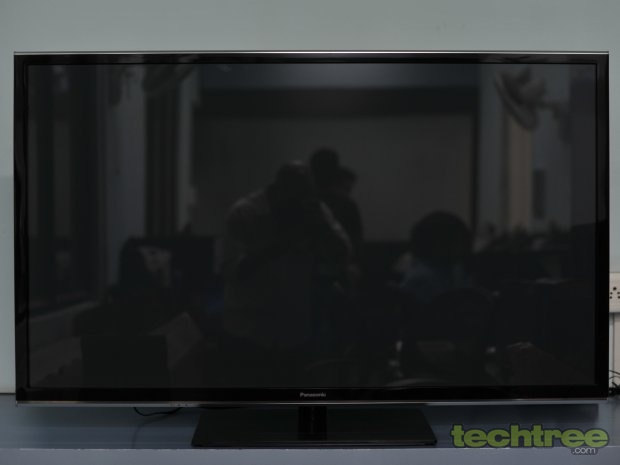
Excessive screen glare is a problem unless you substantially darken your room
Design and Build Quality
Most people are concerned with how a TV looks when its switched off. I personally find gaudy silver bezels and unnecessary light show to be quite distracting. The Panasonic S60D has an all-black theme going on with the bezel and stand; interrupted only by a single chrome strip at the bottom of the bezel. At just over 3-inches, the TV isn't exactly thin but it's no CRT either. Practically speaking, it's only 3 cm thicker than an equivalent 50-inch Panasonic TH-L50E6D LED TV. So there's something seriously wrong with your furniture, if it cannot handle three extra centimetres. More importantly, I don't see how depth matters when you're viewing a TV from the front.
The only reason why we even care about these pointless parameters is because we have been brainwashed by marketing campaigns to that effect. Weight is another bubgear when it comes to plasma TVs. At 21 kg, the plasma is just 3.5 kg heavier than its LED cousin. This is surprising, considering the fact that the S60D plasma TV is built solidly with a glass panel and sturdy metal chassis. I would take the extra heft any day over the flimsy plastic chassis and wobbly stands that plague almost all LED TVs available at this price and beyond.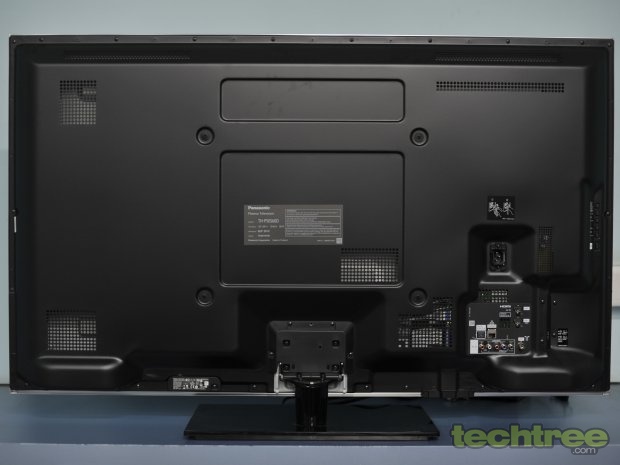
Connectivity and Features
Being the cheapest offering in Panasonic's plasma range, the S60D doesn't sport spectacular connectivity options. You get two HDMI inputs, a pair of USB ports, component and composite inputs, RF cable TV connector, and an Ethernet port next to an optical output. Other features include DLNA compatibility for watching movies, photos, and music over the home network. The TV includes wired and wireless networking and a basic browser, but don't bother using it since it's no fun without a smart remote. The inbuilt media player is fast, handles Full HD content well, and plays every major file format you can throw at it.
There are interesting additions such as the Viera Remote 2 app that turns your Android/iOS smartphone or tablet into a second screen that can either push video, picture, and website content to the TV, or pull the same onto the mobile device. You can even use the app to control your TV. The Swype and Share 2.0 feature allows you to share videos, photos, and web pages between the TV and mobile devices. The two USB ports can also be used to copy files between flash drives. The remote control may be small, but the buttons are large and differentiated well by shape and clever positioning. This makes it easier to operate the TV intuitively even in the dark.
Performance
The TV isn't easy to calibrate thanks to a barrage of unnecessary video processing gimmicks thrown into the options menu. However, once you turn them all off, the results are spectacular. As expected, the Panasonic S60D impressed with its performance in the black level and white saturation tests. It easily showed every single colour swatch in contrast gradient test. That includes the hard-to-render red and blue gradients.
The gamma was near perfect, whereas the gradient banding test showed no sign of banding, discolouration, or any other dithering artefacts. What impressed the most were the response time, motion blur, and viewing angle tests. The colours and gamma levels were rock solid, no matter how further I shifted from the ideal viewing position. Response time is lightning quick, whereas motion blur is conspicuous by its absence. It just beggars belief how much better this TV performs over really expensive LED-Backlit LCD TVs. These fancy synthetic tests are one thing, but the real-world performance is what matters the most.
The visual fidelity put forth by the Panasonic S60D, especially considering its price, is downright phenomenal. It's hard to put into words the difference an emissive plasma display makes over the sort of image quality we are used to with ubiquitous transmissive LCD panels. The blacks, for example, are convincingly dark. When a pixel is switched off in a plasma TV, it really goes dark. It doesn't half-assedly block light like and LCD panel would. All this was more than evident on The Descent, Pandorum, and Sucker Punch Blu-rays. The TV thoroughly impressed me with the sort of black detail it could pull out of these movies.
The way this plasma TV handles on-screen light sources is even more impressive. The headlamps in The Descent, the exaggerated fluorescent lights in Suck, and the resplendence of The Ark in Pandorum are brought to life by the TVs phenomenal contrast ratio. Once you're used to this sort of contrast, it's hard to go back to the lacklustre image put out by an LCD panel—even the really expensive ones. The wide colour gamut endows the picture with pleasing accuracy. There's no sign of over/undersaturated colours, whereas skin tones are rendered realistically. It's little wonder then that Shaun of the Dead, Zombieland, and Star Trek Blu-rays appeared absolutely stunning. It's hard to go back to a regular LCD panel once you have witnessed something of this calibre.
The Last Hurrah
It's obvious that the Panasonic Viera TH-P50S60D Plasma TV delivers image quality that's hard to achieve with LED-Backlit LCD TVs costing many times as much. But being an entry level offering, it lacks anti-glare coating. This means it cannot be used in a room that isn't sufficiently darkened. Then again, this isn't the sort of TV that you'd use for watching Saas Bahu serials. It's meant to be treated as a home cinema screen instead. And that's a role it plays to perfection.
If you're concerned about Panasonic shutting down the production of plasma panels, you have an even cheaper Full HD plasma alternative from LG at hand. Thankfully, both LG and Samsung seem to be committed to manufacturing plasma TVs; especially since they have both released full-featured flagship plasma TVs in their 2013 TV range. As tragic as Panasonic's pull out from the plasma game is, I really hope it sells its patents to either LG or Samsung—much in the same way it bought Pioneer's plasma TV patents when the latter shut shop. Wishful thinking aside, for those who really appreciate good picture quality, this TV worth every paisa.
Features: 4/5
Design and Build Quality: 4.5/5
Performance: 4.5/5
Value For Money: 5/5
Mojo: 5/5
Overall Rating: 4.5/5
Review: Panasonic VIERA TH-L55WT50D
Excellent image quality comes at a price.

Excellent display quality; IPS screen with wide viewing angles; Good sound; Stylish looks with thin bezel; Excellent USB media player with extensive file format support; Wi-Fi, DLNA, Low power consumption.
Slight flickering in 3D; Expensive.
Panasonic Smart VIERA TH-L55WT50D
MRP: Rs 2,73,000
Large screen TVs are not everyone's cup of tea, but there still exists a consumer segment that doesn't even consider going for anything less. If you do happen to have a large living room, a 32" TV will surely look tiny and out of place. Going for a 50" and above then seems reasonable. Of course, cost is not a supposed to be a factor then. The Panasonic Smart VIERA TH-L55WT50D is a 55" LED-backlit LCD TV that fits the above description. It sports an IPS panel with wide viewing angles and 1600 Hz backlight scanning that claims to display smoother motion in movies. Like all such high-end TVs, it can play 3D content using 120 Hz active shutter technology and can even convert 2D to 3D on the fly. We have tested and reviewed this awe-inspiring television.
Accessories
3D Eyewear
Panasonic provides two pairs of active shutter 3D eyewear with this TV so that at least two people of a family can watch 3D movies together. At 31 grams, this is one of the lightest battery-powered eyewear that I have come across and it is very thin as well. The glasses are big enough to cover almost the entire field of view and can be worn over prescription glasses. Unlike previous versions, this one is powered by a replaceable standard CR2025 button cell such as the one you would find on a computer's motherboard, thus saving you the hassle of having to periodically recharge it. It automatically switches off when it detects that 3D viewing is not being done for around 10 minutes. The battery is said to last for around 75 hours at a stretch, as compared to the 30 hours that a rechargeable battery lasts in the previous version.
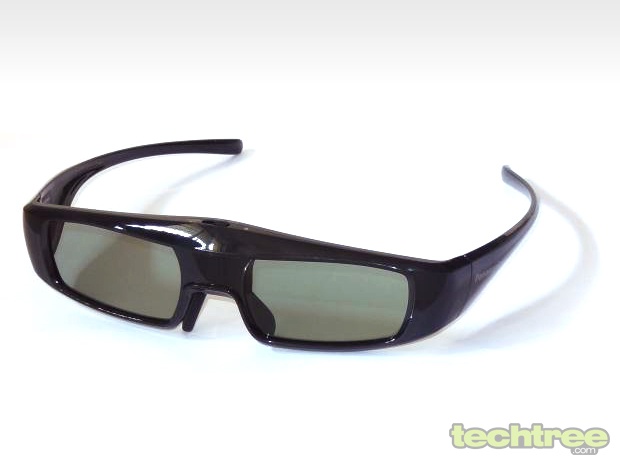
The 3D Eyewear is very comfortable to wear
Remote Control
The remote control powered by two AA batteries is quite long and comes with all the neatly labelled function buttons necessary to completely control the television. Additionally, it has the VIERA Tools and VIERA Link media control function buttons. All the buttons are neatly labelled and it is easy to find what you are looking for on this remote. Panasonic has paid attention to subtle details such as making the buttons backlit with a red LED that can be switched on by a dedicated button and stays on for 5 seconds. Also, the colour red is chosen because it doesn't adversely affect the viewing ability of the human eye in the dark.

The full function remote control can completely control the TV and connected devices
VIERA Touch Pad Controller
This TV also comes with a pebble-shaped VIERA Touch Pad Controller unit that is extremely small and has just a few buttons and a touch pad, but is still capable of doing almost everything that is possible with the larger remote, thanks to gesture control. This controller is basically meant for convenience and its intuitive interface makes it very useful.
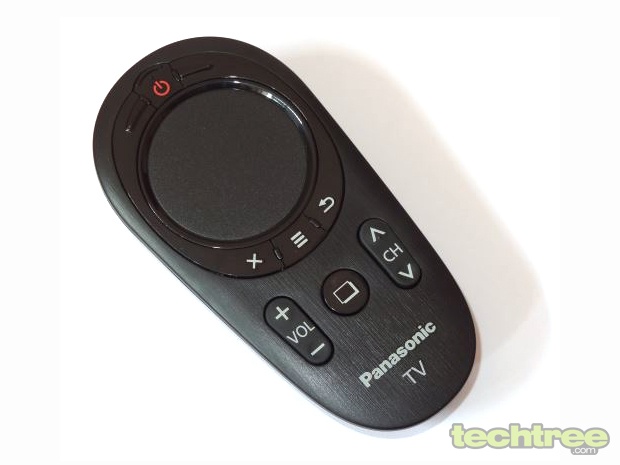
Convenience and intuitive interface makes this touch pad controller special
Design And Features
The Panasonic VIERA TH-L55WT50D is a huge television with a size that makes it suitable to be installed only if you have a large living room. Describing its presence in words cannot do it justice because its sheer size is overwhelming. Before you decide to purchase it, you should know its dimensions to decide how and where to install it. Its height without the stand is 73 cm, width is 123 cm, while the thickness is just 2.3 cm, which is incredibly thin. We think that it is best to install it on a wall, but if you wish to use the pedestal stand, then you must keep in mind that this stand has a thickness of 34 cm. The metallic pedestal stand is of a beautiful crescent shape and allows the TV to be angled laterally to suit the viewer. You will therefore have to make sure that there is enough clearance between the TV and the wall behind, to allow for the 15 degrees left and right swivel. Also, if you decide to place it on a platform, you have to keep in mind that the platform can comfortably hold the TVs 19.5 kg weight, which is actually not so heavy when you consider its large size. When wall mounted, the weight is 17 kg, so the wall brackets must be affixed well — a job best left to the Panasonic technicians.

The Panasonic VIERA TH-L55WT50D
The first thing we noticed about the VIERA is its large glass screen that extends almost from edge to edge, bordered by a 1.1 cm thin dark bezel. The visual effect of the thin bezel is that it makes the TV appear to merge into the wall once it is wall-mounted and adds to its aesthetics and viewing experience. The panel itself has a glossy finish, which should have ordinarily made it difficult to view when placed opposite to a bright source of light such as a window. However, the Clear Panel Pro filter on the screen seems to heavily cut down on the reflections as it reflects a very small fraction of light that falls on it and makes for a comfortable viewing experience. It does catch fingerprint smudges, so it is best to leave the glass untouched with your hands. The beauty of this TV set has been accentuated by a thin transparent strip present below the bottom bezel with the Panasonic name at the centre that lights up by white LED when the unit is switched on. Various grills are located on the aluminium back-cover to vent out hot air produced inside.
Control buttons are completely absent at the front. Instead, they are all placed on the left side, just behind the bezel.
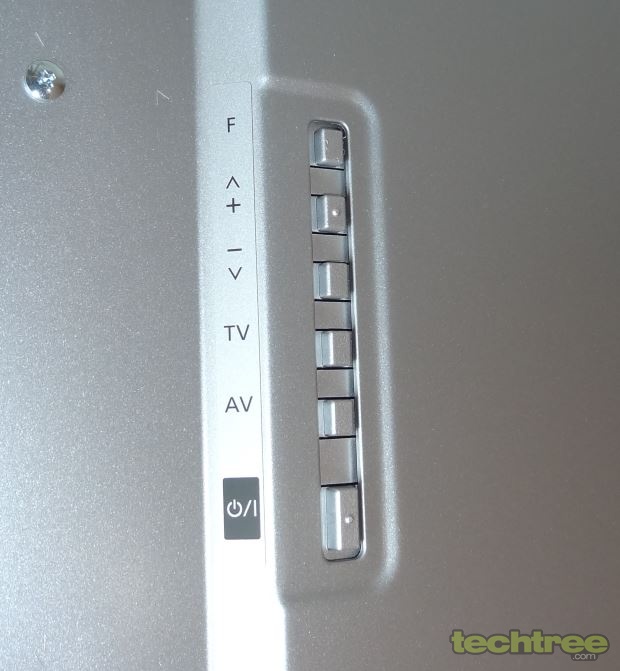
Controls and connectors present on the left side
Most of the commonly used connectors are present at the back on the right hand side, from where they can be easily accessed even after the TV is wall-mounted. These include four HDMI ports to connect HD sources such as an HD set-top box, Blu-ray player, HD media player, gaming console, and PC. There are two AV input ports (one at the back) to connect legacy devices such as an analogue set-top box or DVD player. There is even a headphone jack. Of course, if you really plan to use this headphone jack, then you will need a really long cable due to the huge size of the TV screen making it impractical to watch from too close.
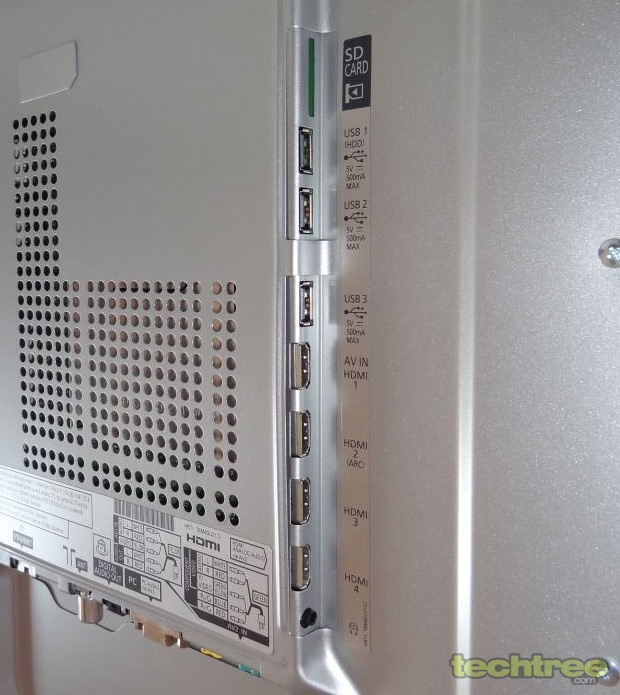
A wide range of connectivity options is present at the back
Panasonic has also provided three USB 2.0 ports and an SD card slot to view movies, pictures, or listen to music placed on these media types. It supports playback of 1080p video and supports just about every file format. File system is also not an issue as it can support FAT32, NTFS, as well as exFAT. It worked with USB drives as large 2 GB and there should be no reason for it to not work with larger capacity drives.
There are a few more ports at the back, facing down and these may be better accessed when the TV is on the pedestal stand than when it is wall-mounted. An AV out has also been provided which can be connected to a recording device. Cable connections can be connected to the co-axial connector present on one side of the collection of these connectors. A lone RJ-45 port (Ethernet) is present nearby to connect and make use of DLNA/VIERA CAST/Internet features of the TV. There is even a D-Sub (VGA) input to connect an older PC.
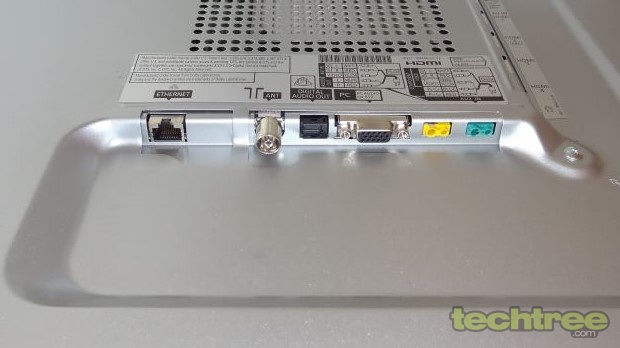
Connectors present, facing down.
Some of the other notable features of this TV include in-built Wi-Fi and DLNA, which makes it easy to use it on a home network to display content from supporting devices that are present on the network. VIERA CAST is yet another feature, which allows you to enjoy internet content such as YouTube, Skype, photos, movies, and weather on the TV screen.
Performance
We connected the TV to the Amkette FlashTV HD media player using a HDMI cable to view HD movies, and to a PC using an HDMI v1.4 cable to view 3D content using NVIDIA 3DTV Play software. A Tata Sky+ HD connection was used to find out the quality of standard television programming and a few HD channels being offered.
HD HQV Benchmark
The VIERA scored high marks as far as the colour range is concerned with smooth gradations like we have never seen before on an LED TV. The black levels are very good and compare favourably against plasma panels. It came off with flying colours in every test that was thrown its way, including the Video Resolution Loss and Noise Reduction test.
2D Picture Quality
Watching HD movies on this TV was a wonderful experience due to its rich colours and contrast levels, wide viewing angles, and the larger-than-life and crisp imagery. The colour reproduction is natural with no noticeable saturation. The TV is very bright, probably a result of it being ready to display 3D in full brightness (as you will read in the 3D test). We actually had to turn down the brightness a few notches to be able to comfortably view without straining our eyes. This is actually a good thing because panels become dimmer as they age and the extra high brightness should make this one last longer.
HD channels from the set top box look amazing on this TV. Switching to SD channels was found to be surprisingly good, although you can't help but notice some blurriness due to the SD content being blown up to such a large size screen. Also, you end up with vertical bars on the left and right when watching at the correct aspect ratio, because the display is 16:9 widescreen, while the current SD channels offer only 4:3. Since the quality of normal Cable TV is generally worse, we recommend against using it with this TV.
Audio is surprisingly good for a TV. The bass is quite good, thanks to the 75 mm driver at the rear that takes care of this frequency range. There are eight train speakers inside to take care of the other audio frequencies and these make it possible to produce highly directional audio, which is something hard to come across in a TV set. Most of the speakers open up at the rear, while some are directed down. The dialogue clarity is amazing and the audio is loud enough that you will rarely need to turn the volume above 50%.
3D Performance
In order to be able to view 3D content, you can connect this TV to a PC capable of producing 3D video output, or a 3D Blu-ray player, which will limit the possibility to just using 3D Blu-rays, or simply play 3D content off a USB drive as the TV can automatically detect the content type and display accordingly. When using a PC, you can view a variety of 3D content including computer games. In our case, the TV was connected to a PC equipped with NVIDIA 3DTV Play and a 3D Blu-ray drive.
Space Station 3D, Avatar, Transformers: Dark Of The Moon, and The Adventures Of Tintin were used to gauge the 3D performance in movies. Additionally, the TV's 2D to 3D conversion algorithm was also reviewed. This TV really immerses you into the 3D world it recreates around you delivering an overall experience almost rivalling that of a movie theatre, owing largely to the large size images. The 3D experience would have been good enough to even convert sceptics of 3D into fans, had there not been the slight and ever-present flicker in this mode. This makes it difficult to watch the movies for long hours, at least for those with sensitive eyes. Other than this issue, there was no crosstalk or ghosting issue, which has been one of the common complaints about 3D. You can turn your head or even move around the TV and get the same 3D experience. As mentioned earlier, the brightness is quite high, thus taking care of another common complaint against 3D of dim images.
This TV also supports playback of 3D content through its own media player as it can detect almost all 3D standards such as Frame Sequential, Side by Side, and Top and Bottom. The TV allows adjustment of 3D settings including swapping of left and right images if they are not proper. You can also adjust the 3D depth, which is actually the adjustment of the inter-ocular distance (distance between the eyes). While this distance is 6.5 cm on an average, a little more or less can cause discomfort, and this setting helps to adjust inappropriate settings hard-coded in some 3D contents to make for more comfortable 3D viewing.
Other Features
The built-in media player works so well that you won't really need to use an external player, except if you want to play off optical drives. The interface of the media player consists of separate sections for pictures, music, and movies. However, the listing of files can lead to confusion and navigation can be a problem because the directory structure is not clearly visible. File access seems to be as quick as from a dedicated media player, and this one also supports subtitles of formats SRT, TXT, and SUB. It also supports files with multiple audio streams, letting you select the one you want to hear. The dedicated playback controls on the remote control come handy while using this media player.
Power Consumption
Having reviewed large screen TVs before, I didn't have high hopes as far as the power consumption is concerned. However, I was pleasantly surprised that this TV consumes less power than even a 40" LCD TV bought around a couple of years ago. The power consumption was found to be around 60 W in the Eco mode, while it lingered around 100 W in the normal mode. Even when you enable Dynamic Contrast, expecting to bump up the power consumption, it remains at just around 110 W. To keep things in perspective, a moderately powerful PC with a graphics card consumes just about the same. In fact, this is the first large-screen TV that I have come across, which can work off a power inverter. When set to Normal mode, the unit consumed an average of 0.1 unit of electricity in an hour, which is not really much for the size. Unlike plasma TVs, this one doesn't generate measurable heat and is comfortable to view for long hours even with no air conditioning.
Verdict
The stylish-looking Panasonic VIERA TH-L55WT50D will blow you away with its sheer size and performance. The 55" panel is really huge enough to turn your living room into a mini theatre for your private screenings. The image quality of the IPS panel is top-notch and the images are crisp, rich in colour, and bright. While it is not as good as plasma TVs, the black levels are nevertheless very good and you are unlikely to see greys when you are supposed to see black. The 3D experience is better than most TVs, as Panasonic has taken care of brightness and crosstalk, but there is still some flickering that may not allow you to watch 3D content for long hours. Two pairs of 3D glasses are provided, but you can buy more if you so require.
The USB media player is one of the best we have come across in a television and almost makes it unnecessary to purchase a separate media player. It supports almost every file format, file system, and even works with large capacity external hard drives. Unlike a plasma TV, the power consumption is quite low for a 55-incher as it consumes only as much as a moderately powered PC. At an MRP of Rs 2,73,000, this may seem to be an expensive proposition, but the money is well worth it when you consider the unique viewing experience that it delivers right in your living room. If you search around, you can actually get it for over 22% less on online shopping portals at around Rs 2,13,000, making it a more attractive buy for those who can afford it.
Design And Build: 4.5/5
Features: 4.5/5
Performance: 4/5
Value For Money: 4/5
Mojo: 4/5
Overall Rating: 4/5
TAGS: Displays, Panasonic, VIERA
Review: Nokia Lumia 620
Easily one of the best value for money smartphones currently available in India.

Excellent build quality; Thoughtful design; Crisp display; Impressive camera, Sleek and fluid UI; Offline voice-guided Sat Nav; Rich social networking experience; Great sound quality.
Lacks FM radio; Not many games available.
Nokia Lumia 620
MRP: Rs 16,000
Street Price: Rs 14,000
After garnering positive responses in the top-end Windows Phone 8 smartphone range, Nokia is now focusing on the budget market. Last year, Nokia tried to crack the sub-15k smartphone segment with its Lumia 610 and 510, but with little luck. Going by their below-par specs and OS restrictions, you knew whom to blame for the dismal sales. But things look different now, with Windows Phone 8 and the latest Snapdragon S4 chipset in tow, the Lumia 620 is ready to fight off a myriad of Android devices.
Design And Build Quality
Similar to its older sibling, the Lumia 820, this phone also comes with replaceable outer shells. So if you get bored of the existing hue, you can simply buy a new shell and give it a new look. The covers are available in youthful green, yellow, and cyan. However, to cater to the not-so-young-at-heart audience, Nokia has also rolled out the serious black and white covers too. All the shades offer matte finish except for green, which offers glossy finish.
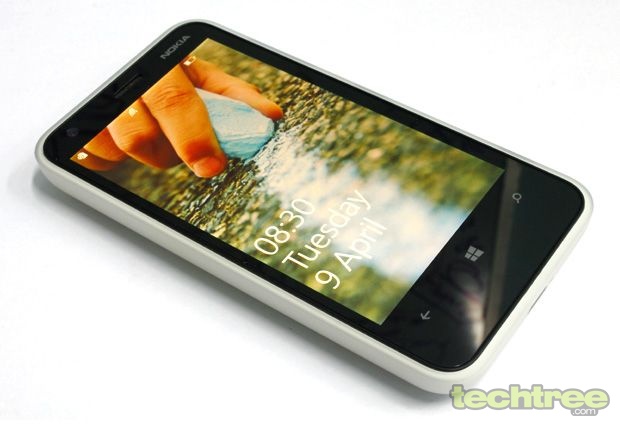
Upon close inspection, the shell reveals its dual-shot construction. In simple words, it features a layer of conventional coloured plastic with a translucent layer on top of it. This not only helps with the aesthetics, but also rules out the possibility of losing colour.
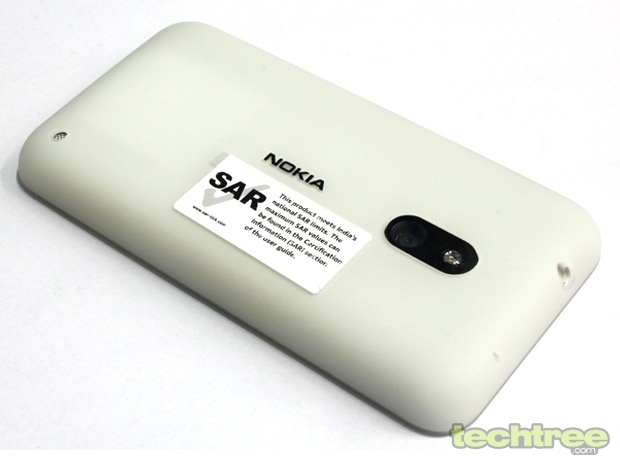
 To accommodate microSD card slot and user replaceable battery, the Finnish giant has done away with the unibody design. However, the minimalistic design approach is still evident. At 11 mm, the 620 isn't thin, but it's compact and fits perfectly in your palm. Volume rocker, Lock button, and shutter key are on the right side. A 3.5 mm jack is at the top, while the bottom side hosts a micro-USB port. Of these buttons and ports, the headphone jack has been integrated in the back cover. In case the water goes inside the audio jack, the damage will be limited to that part only, and your hard-earned smartphone will be unharmed. So instead of seeing your handset stripped naked by a repair guy, you can simply get rid of the problem by replacing the shell. Overall, with the Lumia 620, Nokia has delivered a thoughtful design in a sturdy package.
To accommodate microSD card slot and user replaceable battery, the Finnish giant has done away with the unibody design. However, the minimalistic design approach is still evident. At 11 mm, the 620 isn't thin, but it's compact and fits perfectly in your palm. Volume rocker, Lock button, and shutter key are on the right side. A 3.5 mm jack is at the top, while the bottom side hosts a micro-USB port. Of these buttons and ports, the headphone jack has been integrated in the back cover. In case the water goes inside the audio jack, the damage will be limited to that part only, and your hard-earned smartphone will be unharmed. So instead of seeing your handset stripped naked by a repair guy, you can simply get rid of the problem by replacing the shell. Overall, with the Lumia 620, Nokia has delivered a thoughtful design in a sturdy package.Display And Specs
The 620 features a 3.8" IPS screen with 800x480 pixels, protected by a hardened glass. The screen is impressively bright and has wide viewing angles. The colour reproduction is unmatched by any of the similarly-priced handset. Thanks to the ClearBlack tech, the display produces deeper blacks. Sunlight legibility is another area where the phone shines. Overall, the display is outstanding for a budget smartphone.
This phone is powered by a Qualcomm Snapdragon S4 chipset with a 1 GHz dual-core CPU and Adreno 305 GPU. Other features include a 5 megapixel auto-focus camera with an LED flash to keep it a company, 512 MB of RAM, 8 GB internal storage, and microSD card slot (up to 64 GB). Full specifications are at the end of this review.
UI And Applications
The Windows Phone OS is no stranger for cellphone enthusiasts anymore, still I'll run through the most important WP8 features. In its latest iteration, you can now customise Live Tiles with three sizes. Unlike the previous versions such as 7.5 and 7.8, you get mass storage mode and Bluetooth file sharing options in WP8. And of course, you can share internet with up to eight devices using the Wi-Fi hotspot feature.
Another major tweak includes an improved lock screen that can display updates from apps, and pulls background images from Bing and Facebook feeds. As mentioned in earlier reviews, WP offers extremely deep social networking integration. So if you're a Facebook addict, this is the phone for you. Last, but not the least, the handset does not lag. Yes, I'm looking at you Android!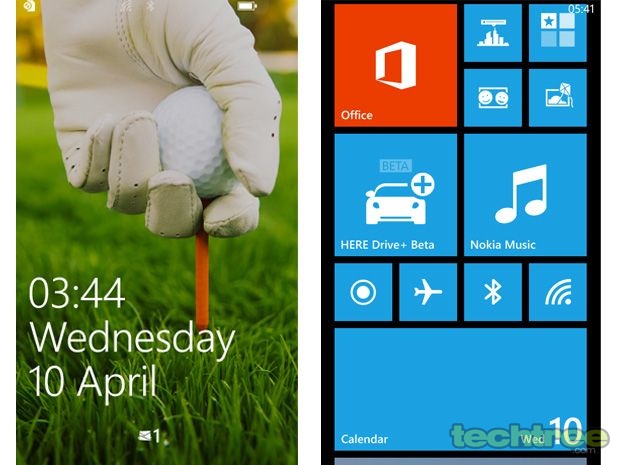
Leveraging on Nokia's $8.1 Billion acquisition of Navteq, the 620 brings offline voice-guided Sat Nav to the table. Now branded as HERE Drive+, the app allows you to download map data right on the device. Depending on your needs, you can either choose to install the all India map, which fits in 603 MBs or opt for the individual data pack for each state. The voice instructions are available in more than 50 languages including Hindi and Tamil. During my week's usage, not once did it take more than 30 seconds to lock onto satellites, even when there was no SIM card.
Nokia's PhotoBeamer is one of the most underrated app. Leaving aside all the technical mumbo-jumbo, this nifty software allows you to share your pictures on any web-enabled device. Just visit photobeamer.com on a device where you wish to display the photograph. Open the PhotoBeamer app on your phone, and simply point it at the QR code that appears on the website. The photos on your device get mirrored on the other device (the speed depends on the internet or Wi-Fi connection speeds).
Apart from these Nokia-exclusive apps, you get Microsoft's Office Suite. Needless to say, it comes with SkyDrive integration. The mobile version of IE10 is HTML5 compatible, and offers zippy page rendering speeds. Other MS apps worth mentioning are Xbox 360 Smart Glass and Bing Vision. For details, go through our Lumia 920 review.
Microsoft's app repository now houses over 130,000 apps, and is growing at a good pace. It's undoubtedly enough for a normal user. However, I'm sure that the lack of Instagram will drive many hipsters away from this phone. And, going by the sheer number of games, the WP platform has a long way to go before catching up with Google's Play Store or Apple's App Store.


Multimedia
Going straight to the point, the handset's sound quality is great. The loudspeaker is indeed loud. Apart from the default music player, the phone comes with Nokia Music. It's better to opt for the latter since it offers equaliser settings and Dolby enhancement. Moreover, it offers unlimited free track downloads for a year. The bundled earphones are just ok, but not in the same league as Samsung, who ship much better IEMs with its phones.
Like every other WP8 device, this one also lacks FM radio. According to Nokia's official blog though, the Snapdragon S4 chipset consists of a radio receiver, so a future update might enable this feature. Coming to the subject of video playback, the phone is compatible with MP4, WMV, and AVI videos up to 720p resolution. However, MKV videos are still a no-go.
The 5 megapixel snapper is surprisingly good. The resulting pictures contain incredible amount of details for a budget phone. More importantly, the colours look natural. Click here, to download the untouched sample. Similar to the high-end Lumia 920, this one packs in Nokia-exclusive lenses such as Cinemagraph, Smart shoot, and Panorama. To find out the usage of these camera plugins, go through our detailed article about Nokia's nifty camera tricks.
At max quality, the Lumia 620 can record 720p videos at 30 fps. The clips are saved in MP4 format, and offer quite smooth playback.
Telephony And Messaging
The People Hub not only takes care of your phonebook, but also integrates your Facebook, Windows Live, Twitter, and LinkedIn contacts at one place. I really like the way how the alphabet tiles help you find the desired contact with minimal scrolling. Moreover, the OS offers extremely responsive on-screen keyboard, when compared to Android. The handset's call quality and network reception were excellent during our tests. Other connectivity features such as Wi-Fi and 3G also worked fine.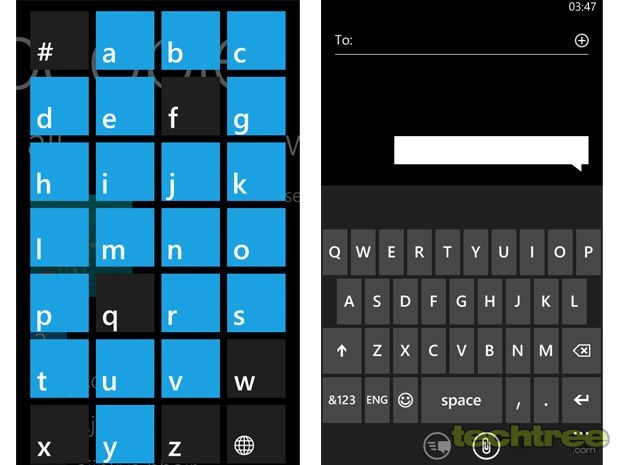
Battery
The 620's 1300 mAh Li-Ion battery may look underwhelming on paper. However, it's good enough to keep the device up and running for a day and half to two depending on your usage pattern. In our 720p video loop test, it lasted around 6 hours, which is quite good.
Verdict
Available for around Rs 14,000, the 620 offers outstanding build quality, great camera, and an impressively screen. Thanks to the 1 GHz dual-core Snapdragon chipset, you get to experience fluid interface at a budget price. Nokia exclusive apps including HERE Drive+, Nokia Music, and a bunch of camera apps sweeten the deal further. This phone's closest competitor, HTC 8S is priced at around Rs 18,000. Therefore, if you're looking for a sub-15k smartphone, the Lumia 620 should top your wish list. Unless, you believe in bigger the better ideology, and have decided to take the 'phablet' route.
Features: 4.5/5
Design And Build Quality: 4.5/5
Performance: 4.5/5
Value For Money: 4.5/5
Mojo: 5/5
Overall Rating: 4.5/5
Specification:
- Quad-band 3G (850 / 900 / 1900 / 2100 MHz); quad-band GSM (850 / 900 / 1800 / 1900 MHz).
- 3.8" TFT WVGA ClearBlack screen with pixel dimensions of 480x800.
- 1 GHz Dual-Core Snapdragon S4 processor, 512 MB of RAM.
- 8 GB internal storage.
- 64 GB microSD card support.
- 5 megapixel rear camera with autofocus and LED flash; Video capture: HD 720p at 30fps.
- VGA front camera.
- NFC, Wi-Fi, Bluetooth 3.0, A-GPS (Glonass).
- Micro-USB; 3.5 mm audio connector.
- 4.5" (l) x 2.4" (w) x 0.4" (11.02 mm) (d); weighs 127 grams.
TAGS: Mobile Phones, Windows Phone, Nokia, Lumia
Will Smartphones Bring Wristwatches Back in Vogue?
What does the post-Pebble era have in store for Patek Philippe’s 1868 invention?
-
Raj Narayan
03rd Feb 2013
While scouring around the web for interesting anecdotes on the hugely popular smartphone revolution, I came across this interesting tidbit about how the iOS and Android powered mini monsters killed the wristwatch and how they could probably end up restoring its pride of place too.
No prizes for guessing that the game changer in the ‘Life of a Wristwatch’ is Pebble, the ubiquitous ‘smart-watch’ (MS Word doesn't yet recognize the word spelt without a hyphen), which shipped the first of its 21st Generation watches just over a week ago.
What went out of fashion as a result of people telling time off their mobile phones is all set to make a grand return, writes Mike Elgan in Datamation.com. Given the insatiable appetite for newer features among mobile phone users, the time for smart-watches taking on the role of a second screen is just round the corner. Elgan writes that Apple and Google will set the trend going.For the uninitiated, the Pebble smart-watch is an e-paper Watch with a 1.26 inch 144x168 pixel b/w LCD display with backlight, a vibrating motor, a magnetometer, ambient light sensors and an accelerometer. It communicates with and Android and iOS devices using Bluetooth. (Read The Verge.com’s review right here).The concept of using a watch to connect with the smartphone came from Eric Migicovsky who raised money via the crowd-funding Kickstarter platform to successfully launch the product, days after announcing it at the CES 2013 confluence of consumer technology giants in the Las Vegas.If smartphones could be the second screen to television, why should it surprise us that a wristwatch is playing the same role for the mobile?Elgan goes on to list out five strong reasons why the very same phones that took the sheen off wristwatches, will restore its pride of place in the months ahead. The reasons are listed below (Click Here for the full story):- The Multi-Screen Functionality: Gone are the days when devices wouldn’t talk to each other. Elgan says that wristwatches will soon show text messages, caller IDs, emails and a host of other stuff that your cellphone receives as a matter of routine.
- Wearable Computing: Ever since we read about Google’s Project Glass, there is general consensus that information can be served even more directly to our eyes than currently possible. Given that such eyewear-based computing could be expensive, the next best option should be a smart-watch.
- Voice Interaction: The writer feels that Apple’s Siri made a breakthrough in this technology and the next step would be to talk into your watch, get your smartphone to compute and then feed the answer back to your wrist. Tap the watch, instead of the phone, says Elgan.
- The Flexible e-Paper: Smart-watches aren’t a new phenomenon, but past editions have suffered from bulk and poor battery life. This is where yet another Kickstarter project codenamed the ‘CST-01’ arouses interest. Developers are building the world’s thinnest wristwatch that one wraps around the wrist, thanks to ‘flexible e-ink’ technology.
- Bluetooth 4.0: Reduced power consumption for a Bluetooth connection is good news, feels Elgan. What makes the smart-watch incredible is the lower-power e-ink screen and the latest Bluetooth working in tandem with the fact that all the processing is happening on a smartphone.
Looks like the smart-watch will be to the smartphone what the fast-disappearing mouse is to the desktop and laptop.
Top Five Smartphones Under Rs 10,000 (January 2013)
Out of the myriad budget mobile phones, we pick five which should be in your shortlist if you are looking for one within the Rs 10,000 mark.
-
Chandrakant 'CK' Isi
11th Mar 2013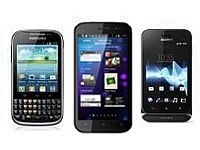
Buying a premium smartphone is relatively simple because there are only four to five handsets battling it out for the top spot — at least, you don't have too many number of devices to choose from. In contrast, the budget segment has the problem of plenty, aided in no part by domestic brands churning out inexpensive phones in every possible size. Most of these handsets have all the essential features such as such as 3G, Wi-Fi, and at least a 2 mp camera. While it's good to hunt for a feature-packed phone, you shouldn't turn a blind eye towards build quality, unless you're planning to buy a new phone each year (if not more frequently). Here are five phones under the psychological mark of Rs 10,000. The listing is in order of price and is not necessarily a ranking.
[The prices are store prices as on the date of publishing]
Nokia Asha 311
Price: Rs 6100
While not being termed a smartphone, the Asha 311 is perfect if you're looking for an easy-to-use feature packed phone, spending only as much money as as absoluty required. The phone's 1 GHz processor handles the Series 40 touch UI effortlessly. You get great sound quality, a decent 3.2 mp camera, Wi-Fi, Bluetooth, 3G, and a bunch of features that you generally find on smartphones. The Asha 311 also has TV-Out functionality. Add a 3" display protected by Gorilla Glass, and you get the smartest "dumb" phone on the market.
Samsung Galaxy Chat GT B5330
Price: Rs 8000
If you like QWERTY and you like Android, the Galaxy Chat is the phone for you. The CPU is no great-shakes, but with a speed of 830 MHz it handles Android 4.0 (Ice Cream Sandwich). Apart from that, the handset packs in a 3" capacitive touchscreen, a 2 MP camera, A-GPS, and Wi-Fi connectivity. After a recent price drop, you get the best of both worlds for Rs 8000. Sorry BlackBerry, your Curve 9220 is good, but better luck next time.
Sony Xperia tipo
Price: Rs 8400
The tipo is the most affordanle in Sony's Xperia lineup. Despite its modest price tag, the phone offers impressive design and build quality. I'd go on to say that it's one of the best looking phones in this segment, and does justice to Sony's reputation for making their phones look attractive. It's 800 MHz processor and 512 MB of RAM may not sound impressive, but is good enough to handle Android 4.0 (ICS). Other features include a 3.2 mp camera, Bluetooth 2.1, Wi-Fi, and A-GPS. There's also a dual-SIM variant, which costs a grand more.
Motorola Defy mini
Price: Rs 9400
I personally don't like Motorola's customisation of Android. Moreover, a feeble 600 MHz CPU doesn't do the Defy mini any favour either. Then what's it doing in a list of 'best' phones? This phone is unmatched when it comes to ruggedness in this segment. Be it dust, shocks, or even water, the Defy mini can stand it all - at least, better than the rest. The phone's 3.2" display has modest pixel dimensions of 320x480, and is protected by Corning's Gorilla Glass. Other features include a 3.1 mp camera, 3G, and Gingerbread OS. It surely doesn't offer the best Android experience for the price, but if you're "blessed" with butterfingers, this is the phone for you.
Micromax Canvas 2
Price: Rs 10,000
If you believe in the "bigger the better" approach toward your phone's display size, a phablet will be in your wish list. I'm not fan of these oversized phones, but if you're sold on the idea of buying one, my recommendation is Micromax's Canvas 2 A110. This dual-SIM handset features a 5" IPS screen, which is better than displays that many similarly price phones offer. The handset is powered by a dual core 1 GHz CPU that does a commendable job handling Android 4.0 (ICS). Apart from that, you get an 8 mp camera, 3G, Wi-Fi, Bluetooth, and GPS. Seriously what more can you ask for 10 grand?
Exclusive: Samsung GALAXY S II Plus Headed For A February Launch In India
The Samsung GALAXY S III mini will not make it to the Indian shores though.
-
Chandrakant 'CK' Isi
14:08 25th Mar, 2013
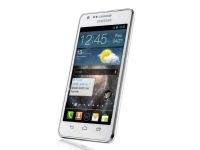
At the Samsung GALAXY Grand's announcement, we had a chance to have a quick word with Manu Sharma, General Manager of Samsung Mobiles. Among other things, we asked his views on domestic handset-maker Micromax, which competes with the Korean giant in phablets segment. While Sharma declined to comment on competition, he added that Samsung did enjoy dominance in terms of quality. But the juicier news was yet to pop out of him.
With regards to the GALAXY S III mini's availability in India, Samsung's GM made it clear that the company has no plans to launch the device in India. He rationalised that it will compete with the newly-announced Grand, and that looking at the phablet craze, people will prefer the latter for its larger screen. So that is bad news for those holding up their purchase for the S III mini.
On the bright side though, fans waiting for the GALAXY S II Plus have something to look forward to. The handset is headed for a late-February launch, and is expected to cost less than 25 grand.
TAGS: Samsung, Mobile Phones
CES 2013: Some Unusual Gadgets
Apart from 4K televisions, smartphones, ultrabooks, and tablets; the CES has its share of unique and interesting products.
-
Rahul R
02nd Apr 2013
[with inputs from Kamakshi S]
The CES 2013, which concluded yesterday, witnessed several new high-tech products and gadgets. While gadgets such as the Sony Xperia Z, Panasonic Toughpads, Flexible Displays, and PaperTablets shone at the event, like every year, the event had its share of the off-beat as well.
HAPIlabs HAPIfork
HAPIlabs claim that the HAPIfork helps users monitor their eating habits. It even warns users when they tend to eat too much food too quickly. An app keeps record of food habits over a time period. The HAPIfork is priced at approximately $100 (approx Rs 5,300). The "smart fork" comes equipped with a Bluetooth radio, a capacitive sensor, and an inbuilt vibration motor. Whenever the fork touches the eater's mouth the sensor is triggered, with the bites and time-lapse between two morsels tracked by an app. If it senses that you are eating too quickly, the fork vibrates asking you to eat slowly.iRobot Looj 330 Gutter Cleaner
At this year's CES, iRobot unveiled two smart cleaning bots, Mirra 530 pool-cleaning robot and Looj 330 gutter-cleaning robot. The latter can clean about 28 feet of gutter spaces in just 5 minutes. The waterproof gadget implements high velocity mechanism for the cleaning process. The iRobot Looj 330 Gutter Cleaner is priced at $300 (approx Rs 16,500).LEGO Mindstorms EV3 Robotic Kit
Want to make your own robot but don't know how to go about it? Then LEGO has just the thing you need! The Mindstorms EV3 Robotic kit helps you build your own robots. The kit gives you instructions in 3D (not stereoscopic 3D) via an iPad on how to build your own Robot. There is also an Android and an iOS app as well. This wonderful Build Robots Yourself kit is priced approximately at $350 (approx Rs 18,550).Bodymedia FIT Armbands
This is a multi-sensor arm band that monitors your exercise regime (even your sleep quality) to keep track of the calories that you have burned. Users can get vital information by using the device as an armband while working out and then connecting it to a computer's USB port. The Bodymedia Armband equipment costs about $111 (approx Rs 5900) along with a Biggest Loser Workout DVD.iMusic Body Rhythm
This interesting innovation lets you physically feel the beats of your favourite music. The vest-shaped device needs to be worn around the shoulders after which you can synch it with you music player. The gadget is Bluetooth enabled, so you can any use this with any Bluetooth-enabled PMP. The price of this device hasn’t been revealed yet.iPotty
Getting kids potty-trained can be quite a tedious task; CTA Digital put up an iPotty at CES, a colourful plastic potty with an iPad attached (the screen is covered with plastic for splash-protection) to keep the young one settled till he / she gets does the "job" done. The iPotty, is expected to be available online by March, starting with Amazon.com.Parrot Flower Power
CES truly seemed to have something for every kind of consumer, and most of these devices seemed to be banking on Bluetooth for connectivity. While it has the silliest of names, this nifty gadget will impress those with a green thumb. Created by a company that calls itself Parrot, this soon-to-be-commercially-available gadget has to be "planted" into soil. It has sensors which send data from the soil of your plant through Bluetooth to an iPad app. The data is then verified against the apps database to inform you when to water a plant, and if it is healthy enough. Pricing details and availability are yet to be revealed.Haier Eye Control TV
Televisions, as usual, were the highlight at the CES this year. As more 4K-enabled (Ultra HD) sets were unveiled by several brands, Chinese manufacturer Haier had other plans for the average couch-potatoes. Its new Eye Control TV set comes with a Kinect-style blink sensor that lets you switch channels, change volume, or power on/off your TV set. Haier also claims that standard blinks will not create trouble with TV viewing experience. Calibrating the setup for the first time involves you "chasing a circle around the screen with your eyes" that can leave you disoriented for a bit. But quite an easy way to never leave the best seat in the room, right?
CES 2013: Just What Was Qualcomm Trying To Do With Its Keynote?
Semiconductor products cannot look 'cool', at least in the largely accepted sense of the word.
-
Kamakshi S
11th Jan 2013
If there is one technology company whose products have been known to pretty much anyone who has used a computer, it's Microsoft (by sheer merit of the products, or lack of competition, or aggressive marketing — that's a different discussion). No wonder then, that the opening keynote at the Consumer Electronics Show (the 2013 edition of which is currently underway) was delivered by Microsoft for 13 straight years. But that ended in 2012, and this year saw a company whose products are behind the scenes in mobile devices, present the keynote. The thing is, unless you are a technology buff, you would not connect with Qualcomm the way you would with Microsoft.
So Qualcomm tried hard to convince us they are guys who make other guys cool. They tried too hard, and that's what was odd about their keynote (you can relive the entire session here). The keynote opened with a skit showing three Gen M (Generation Mobile, if you may) mobile-addicted youngsters who are perennially connected and repeatedly making a point of it (which got irritating after a while). While it is a known fact that all shows are scripted, from the very onset, this one made it very obvious. Watching the three actors on stage I couldn’t figure out if it was a parody or the real deal. Turns out it wasn’t a spoof, and unfortunately, that is how Qualcomm, which claims itself to be "the first mobile company to open the Consumer Electronics Show", thinks an average mobile user is: Youngsters who may soon need therapy to get a life beyond sharing and liking in the virtual world. Microsoft's earlier keynotes did have their own little drama, but those did not become dominant in the presentation; we can't say the same for this year though.
When the charade finally ended, Qualcomm CEO Paul E Jacobs took centre stage to pat his company's back; gave us facts and figures on how mobile the world has become, and of course, he said the Snapdragon processor is at the heart of it all. Now he is no Steve Ballmer, let alone Steve Jobs, when it comes to public speaking and charm. Jacobs was seemingly out of his skin on stage: He was trying to hard to fit in, and be cool. And then, in a move that surprised everybody, Steve Ballmer came running (literally) onto the stage, showing off some new Windows 8 (Samsung Ativ and Dell XPS) and WP8 devices powered by Snapdragon, and pat Micosoft on its back as well for its 'contributions'. This, after announcing in last year's CES that Microsoft would not be delivering the keynote in 2013. Back to the point, alongside Ballmer, his Nokia 920, and Jacobs' HTC 8X also stole Jacobs' thunder. Mobile or not, Ballmer is effective, more than tolerable, and swift: He sprinted in and jogged out of the stage rather quickly!
The first stroke of positivity came in the form of an amazing ad that introduced Qualcomm's next flagship processor, the Snapdragon 800 followed by a quick demo showcasing the capability of the chip: The only time Jacobs appeared comfortable on stage, and knew what he was talking about.This whole keynote begs the question, did Qualcomm really benefit from the limelight it has garnered at CES? You would not walk in to a mobile store and ask for a Qualcomm chipset now, would you? Is the company planning to launch end-user devices of its own, like say, a Qualcomm mobile phone? This is pure speculation, of course, but we know of two cases in which telecom OEMs have entered the consumer space: HTC and Huawei.
Star Studded Affair
Several star guests came up to help Jacobs highlight each aspect of Qualcomm's plans for 2013. These included names like Guillermo Del Toro (who also used the stage to promote is upcoming flick Pacific Rim), NASCAR champ Brad Keselowski (who demoed a new in-TV NASCAR app), Big Bird (yes the one from Sesame Street, and a sad little writer (!) guy 'Dave' dressed as a electrocuted, featherless 'birdketeer' who demoed the Big Bird's Words app), Desmond Tutu (talking about m-healthcare in South Africa), actress Alice Eve (who was probably the most uncomfortable of the lot, came in to talk about a new Star Trek app), and Maroon 5 (who closed proceedings for the day, and seemed to be prepared to face a tough audience).All in all, there was something in it for everyone. Annoying teens to shoot at, gory scenes, drool-worthy cinestars, smarter cars, Windows 8 (and WP8) powered devices, an electric Rolls Royce, an annoyingly abusive boy band, and kiddy's stuff too.
Big Bird was the best part of the show: He and birdketeer Dave were the only persons on stage that weren't uncomfortable, out of character, or pretending to fit in! The lowest point was (not even the condescending opening that the band Maroon 5 started on) the fact that only 3 of the 5 came in, and ended with a rather abusive song, called Payphone. Those who caught the event on live streaming online were in for a ruder shock — due to lack of broadcast rights; the music was first replaced by silence, and then a Dido track over the original. Not a nice way to patronise those who couldn’t make it to the event!
[with inputs from Kailas Shastry]
Sennheiser MOMENTUM Review
Exemplary performance? Luxury in feel? If you have wondered what a 25k headphone is all about, this review is for you.
 Pros:
Pros:
Excellent performance; Superb styling; Replaceable cables; Inline remote control.Cons:
Earpads can be too small for ears; Expensive.Sennheiser MOMENTUM
MRP: Rs 25,000There's no extra zero added to the price above. Yes, it is all of a quarter of a lakh Rupees. High-quality sounds come at a premium price. That might as well be true with the Sennheiser MOMENTUM headphone, which is a luxury product made using expensive materials. In addition to audio playback, these also offer handsfree functionality for the iPhone. Despite its price tag, the company has not classified it as audiophile-grade, which makes me a little sceptical of what to expect. Read on to find out if it is really worth the price it demands.

Design And Features
Luxury: The Sennheiser MOMENTUM features a closed-back, circumaural (around-the-ear) design with neodymium drivers that can produce rich audio ranging from 16 Hz to 22,000 Hz, as per specifications. This pretty much covers the entire frequency range of the average human ear. The leather-bound cans sport a retro look. As per Sennheiser, the soft, fine dark brown leather is from the "traditional English tannery" Pittards. The leather has a light and pleasant fragrance, as compared to the unpleasant odour that is usually associated with the material. Being breathable, it is supposed to allow for longer usage and also be tough enough to endure sweat and water. The earpads are replaceable. The headset is comfortably lightweight at just 130 grams.The headband is made of a thin and flexible stainless steel strip with brushed metal finish. The top portion that rests on the head is covered with same dark brown leather that appears to be hand-sewn at the seams and fastened by four screws each on the left and right ends. The lower side of this portion has foam inside so that it rests gently on the head. The cans can slide across this band via metallic sliders to be adjusted according to your head size.
Restating its premium nature, Sennheiser provides a brown hard carrying case with soft velvet covering, having dual zip locks. There is an additional a compartment to store the two cables, and a 3.5 mm to 6.3 mm audio adapter that has also been provided along. This allows you to connect the headphone to Hi-Fi equipment that usually features such a connector.
Cables and 'Smart Remote': The cables are replaceable, with one end plugging into the left can. This is actually a good thing because it is usually the cables and connectors that go wrong with headphones. Sennheiser provides two 1.3 m long cables in the package: one with and one without the inline controller known as Smart Remote. Audio purists might want to use the one without the inline control. The length of the cables is sufficient to plug them comfortably to the soundcard sockets at the rear of a PC cabinet. The connector of the cable with the Smart Remote is hinged at a convenient angle. The cable connectors do not have gold plating, which is standard with audiophile equipment to reduce electrical noise at the contacts.The Smart Remote is a shiny metallic controller with two volume buttons and with a button in the centre embossed with the Sennheiser logo. The Smart Remote can be used with iDevices and quite a few other mobile phones to play, pause, forward, rewind, skip, and go to the previous track. However, the volume control only works with iDevices. Thanks to the inbuilt microphone, it also works as a handsfree with the iPhone (3GS and above) so you can accept and reject calls as well. That being said, the Smart Remote does not control volume or playback when connected to a PC.
Performance
I must confess that I didn't have very high expectations from the MOMENTUM because although it is a luxury product, Sennheiser doesn't list it as a audiophile headphones on its website. However, I was in for a pleasant surprise, and I must say that the German manufacturer is only being too modest about the capabilities of this product. The audio is well-balanced without any special emphasis on a particular frequency range. Many manufacturers are known to have a bias towards the lower frequencies (bass) because most people like the thump that bass brings. Purists however hate this behaviour. The MOMENTUM tries to keep it as unadulterated as possible. In fact, the audio is so clear that I could actually hear details that I hadn't experienced before.
The headphone passed the frequency test with flying colours. This includes playing back sound at various frequencies using Foobar. It even breezed past the bass test with ultra-low frequency audio files, where most other headphones and speakers tend to falter. The best thing is that there is no noticeable distortion even if you turn up the volume to the maximum (if you can bear to listen to that high a volume).
These are capable of accurately producing soundstage according to the source audio. Fans of western classical music can rejoice because the MOMENTUM recreates accurate positioning of various musical instruments. This also works well while watching movies because it adds that much-sought-after immersive audio dimension.
Having a closed-back design that seals your ears from the surroundings, you can be rest assured that your neighbour will not hear what you are listening to. It also acts as a physical barrier that seals off the ear from the ambient sounds, thus contributing towards an immersive listening experience.
Not everything is well, though. The earcups have a size that is smaller than the average around-the-ear headphone. The oval hollow that encapsulates the ear has a height of just a little over 2" (5 cm) and width of around 1.2" (3 cm), which is smaller than the average male human ear with over 2.4" (6 cm) height. Even after considering the flexibility of the earpads, it still becomes unpleasant (and at times downright painful) when you extend the listening session to beyond half an hour, at a stretch.
The Verdict
The Sennheiser MOMENTUM, although not branded as audiophile-grade, perform just as well. The audio reproduction is balanced across the audio frequency spectrum, which is what a good pair of cans is supposed to do. The retro looks with the premium leather will surely appeal to most. It even works with iDevices with the inline remote control. Thanks to the microphone, it can also be used as a handsfree with the iPhone, although it seems to be absurd to have a handsfree in this price. While it seems cosy to wear, there is a design flaw that makes it unpleasant to wear for extended listening sessions. If you are ready to overlook that aspect, there is really nothing that is wrong with the MOMENTUM. Except of course, the premium pricing of Rs 25,000 (the price is not wrong per se, but it is a bit too much for most people). If you've already bought the rest of your entertainment system and have some serious money left, we suggest you go ahead and blow it on this Sennheiser.
Features: 4/5
Performance: 4.5/5
Ergonomics: 3.5/5
Value For Money: 3.5/5
Mojo: 4/5Overall Rating: 4/5
TAGS: Headphones, Sennheiser, Geek Corner

CES – What's All The Fuss About?
A quick read to know why CES is a big deal in the world of consumer electronics.
-
Team TechTree
08th Jan 2013
Not just tech media, but other sections of the press have gone gung-ho about the Consumer Electronics Show (CES) that is going on in Las Vegas this week. TechTree too has built a temporary CES special section now. If you are wondering why everyone's talking about this event that is happening half way across the globe, then this article is a must-read.
Remember the VCR? If you don't, then you were perhaps born in the 90s or later, so you'll remember CDs for sure. These were both introduced in CES, (way back in 1970 and 1981, respectively). The latest movie dissemination standard, Blu-Ray, too, was introduced in CES in 2003. The 2008 CES saw OLED TV and a year later, 3D TV. You should now be getting the picture... Many technologies that marked a turning point for consumer electronics were launched in this show. Of course, not all launches made at CES become big, but there's always a chance, and as history has shown, some may indeed become big.
Mobility Goes Big
Guess which company delivered the opening keynote at CES for the last 13 years? Microsoft. Most of those 13 years saw the PC becoming omni-present. The more recent years saw the coming of the mobile, and boy, did it come big, and fast. No surprises then that a large chunk of this year's keynote was delivered by the CEO of a company that has played a huge part in the mobile revolution, as it were: Qualcomm.Is CES less relevant today?
There's a lot of talk in the international press and amongst analysts about CES losing some relevance in the more recent years. The large players in the consumer technology space are launching their products in their own show and in timelines that coincide with their go-to-market strategies. RIM (the company behind BlackBerry), is launching their OS 10 in their own event at the end of the month. Apple, of course, has always used its own events to launch products, not wanting to share any glory with others.Nevertheless, last year's CES saw a record number of attendees — so, interest from the journalists and industry folks is still large. Going by some of the launches we have already seen in CES 2013, there's ample for gadget freaks to drool over. While Micosoft had earlier said they would not be participating in CES this year, its CEO Steve Balmer did make a surprise appearance, stealing some limelight from Qualcomm. If the world's largest software company, after deciding to stay out of the event, still makes an appearance at the keynote, it is safe to say that CES, at least for now, is still big.
This year, apart from mobility, other areas that are expected to see action include technology in health care, automotive technologies (of the digital kind), televisions and Windows 8 touch devices.
US Department Of Defence Invests $617 Million On Windows 8 Licenses
Set to save $70 million over a span of three years; says MS' tools meets "specific security needs of the Defence Department".
-
Kamakshi S
13:28 04th Jan, 2013

While the DRDO (Defence Research and Development Organization) prepares its forces to come out with a fully Desi Operating System, citing that the so-called foreign operating systems tend to compromise cyber safety and are susceptible to worms and other security issues, its US counterpart is embracing these OSes with open arms. Reports suggest that the US Army has invested as much as $617 million (approx Rs 33,62,23,04,400) on Windows 8 licenses.
Apart from the Army, the Air Force and DISA (Defence Information Systems Agency) will be using an array of Microsoft products, which includes Microsoft Office 2013, SharePoint 2013, and Windows 8. Officials also said that Office 2013's enhanced security and content management tools "meet the specific security needs of the Defence Department".
While the amount does seem to be a lot, reports suggest that the Department of Defence will save as much as $70 million (approx Rs 3,81,45,24,000) for three years, which is the span on the agreement. Since Microsoft's OS is a home-grown weed for the US Army, they wouldn't have to be paranoid about security snarls like their Indian counterparts, or do they?
TAGS: Software, Government, Windows, Kamakshi
2012 TechTree Wrap-Up Part 12: Facebook's Timeline In 2012
We look back at all the reasons that FB stayed in the limelight, all year long. If you are a Facebook junkie, this is a must read !
-
Kamakshi S
08th Jan 2013
Facebook is like the Big Boss House in many ways. Whatever you do or say is out there for the world to watch. As people become more social on the web than in person, we look back at all the reason for which the social networking giant was in the news, in India:
Spreading Music To The World
There have been add-ons for some IM clients that display the name of the track being played in your media player, as your status message. FB took this to the next level, allowing you to not just share the name of the song, but the song itself, with your friends. A lot of conversations can start with exchanging ideas on music, so this does seem like a nifty addition. To listen to what your friends are playing (if they have enabled this feature), just click the music note on the chat sidebar against your friend's name.Content Monitoring (officially) Begins In India
Delhi HC warned FB and Google to filter content, with the threat of a Chinese-style complete block they wouldn’t get rid of objectionable details. A day later, the Government sanctions orders to prosecute 21 internet firms for "carrying provocative content". In hindsight, the gag on free speech as we know it began before the Palghar incident.Indian Army Bans FB
In a bid to safeguard interests and identities of its Personnel, the Indian Army ordered all its men (women) to stay away from social networks including FB. Would be nice if the armed forces get a social network to socialise among themselves in a close-knit setup.Guinness World Record for most comments
If there was a world record for the most pointless world record, this would be a top contender. Four FourFrontierville fans set a new Facebook record for most comments on a single post with 1,001,552, comments.Outsourcing, FB Style!
As FB grew in numbers and popularity, it saw its share of tumbling skeletons. Unlike its vague privacy policy, a disgruntled former Moroccan employee at oDesk, a third-party content-moderation firm shared some crystal-clear guidelines for data monitoring, which are quite shocking indeed! Few days' later reports of user texts via smartphone apps being accessed and used also started making rounds, which was weakly squashed by the service.FB Messenger For Windows Debuts
Given the in-browser chat feature in Gmail and Facebook, one might think standalone IM apps are passé, but FB does not think so. A new desktop-based messenger was brought to life – the software also intimates users of new comments, photo tags and more.Facebook Under Fire For Blocking Indian Accounts
After several requests to control what goes online, an Assamese tribal community realised how seriously the social network takes its out outsourced-policies. Thousands of accounts belonging to the Chutia community from Assam were blocked without any prior notice, which drew a lot of ire from users. And they don't block expletives where they perhaps need to!Facebook Buys Instagram For $1 Billion
A picture speaks a thousand words is the adage, and FB understand it. FB bought Instagram and several ardent Instagram users feared that their "protected" images will be distributed without explicit content. But then again, you need to understand that if it is on the web, it is never ‘private’ in the conventional sense of the word.File Sharing Comes to Groups
Facebook allowed users in a group to share non-music, and non-executable files of up to 25 GB with ease. The move to exclude music files was to curb piracy. Seriously, haven't they heard of pirated e-books or other file types that can violate copyrights?Facebook's First Divorce Case
In a first of sorts for India, a user’s FB profile was cited as one of the causes for ending a two-month-old marriage of a couple hailing from Aurangabad. Reason? The 28-year-old's husband didn't change his marital status on the social network. Incidentally, the web service is said to be responsible for 33% of divorces worldwide.Can't Get Rid Of Timeline
Not many people warmed up to the timeline concept, despite all of Facebook's efforts. As user's vented their anguish, two scamsters cropped up to revert back to the old user profiles. While one was a browser plug-in which claimed to "remove" FB Timeline from user profiles (only to redirect you to a Turkish domain), the other collected user details through a survey app that posed to be legit. Change may not be a good thing, but why fight it?List Yourself As Organ Donors
On May 1st, Facebook let users in the US list themselves are organ donors. Being the second most populous nation in the country, a feature like this would have worked wonders in India too. And after some soul-searching, AIIMS (All India Institute of Medical Sciences) also started to think about extending this service to Indian users as well. The country's premier medical institute's Organ Retrieval Banking Organisation had plans to take aid from FB to encourage voluntary organ donations and create awareness about it, but nothing materialised by the end of 2012.Indian IT Act Claims Its First Victim On FB
The first time the IT Act claimed it first rightful victim was when Jaipur-based PhD microbiology student Vipin Kumar Chouhan, who hacked into a senior's account and put up obscene posts on his wall was arrested. With this thoughtless act of revenge, the 27-year-old is stating at a 5-year jail term or a Rs 1 lakh fine. So the IT Act is not completely useless, now is it?FB Response Helps Sony fast-forward Xperia Launches
If Sony was trying to gauge its popularity in the mid-range Android smartphones market, then using the Facebook path surely would've surely pleased them. Plans to launch three handsets — Xperia miro, tipo, and tipo dual — was pulled ahead by 9 days, thanks to overzealous fanboys who ensured that the counter ticked faster!Mamata Didi Debuts on FB, Pitches Kalam For President
After a lot of flak online being on a high horse and not being able take a joke in good spirits, Mamata Banrjee made her official debut on FB a "humble, transparent, common person", asking citizens to support Dr Abdul Kalam for Presidential nomination. Unlike snake bites that need its venom as cure, the move didn't do much to change her image amongst netizens.Editing Comments To Save You Skin
As a boon to people with butter fingers on the keyboard, or those with wrong choice of words, the social network enabled comment editing. However it won't cover all your bases, users can view a history of the edited comments.App Center Comes To India
After flaunting an App Center way back in May, and with several apps already available, Facebook seemed to be riding on an eco-system tide, as it rolled out the app repository in June on the mobile platforms as well for users in the US. The app center was finally made available to users in India a month later, which came as a relief: Finally all the Farmville requests moved out of my homepage!Share Your Story With Facebook
Taking its Facebook Stories app initiative further, the social network launched FacebookStories.com, a dedicated site to highlight user videos and articles, on a monthly theme. The website surely seemed to go out of its way to show the world that all the social connections it manages to make a difference.Expecting a Baby? Celebrate With The World!
After adding same-sex couple icons on July 2, FB added a new Life Event for Timeline, so that you can tell the world that you are expecting a bundle of joy, especially when you are lost for words. So now getting a pet, losing a loved one, or experiencing love at first sight, you don’t need to say a word: Just create a new life event!How Facebook Was Used To Fuel Anti-Northeast Sentiments
As hard as Zuckerberg tried to hold FB's social connect flag high, back home, the social networking website showed the uglier side of human emotions. As people from North-East India were bullied and chased out of several cities, it all started with baseless rumours which fuelled hatred from a social network! FB on its part agreed to help the Govt get rid of such "hateful content".Several Stars Debut Officially On Facebook
Although Twitter seemed to be every popular "stars" favourite hangout, some of them have moved to FB as well. This year, Amitabh Bachchan, Sachin Tendulkar, and Salman Khan tried their hands the web service. Whether they will use it actively or not their presence itself will bring glee to their fans' faces.Two Girls Land Behind Bars With A Post!
Palghar and Facebook came into the limelight along with Sec 66A of the Information Technology Act, as two girls from the small town were arrested for posting supposedly "insulting remarks" against the deceased Shiv Sena Supremo Bal Thackeray. The girls were set free on Rs 15,000 bonds. The case was subsequently closed, not without ruffling a lot of feathers.After, Bal Thackeray, Raj Get Abused on FB!
After drawing a lot of flak over how the Police handled the Palghar case, when another defamatory post, this time on Raj Thackeray cropped up, the law enforcement went cautious. The account turned out to be a fake and the incident slipped from public memory rather swiftly.Chandigarh Professor Caught For Making Derogatory Remarks
Similar to the Jaipur student event, the yearend saw a Chandigarh Professor being possibly put behind bars for making obscene comments. Again, section 66A which has been in the eye of the storm for a while came into play, albeit this time, it was used in the right spirit at least!
Internet, Facebook, Government, Security, Sony, Xperia, 2012 Special, Kamakshi
2012 TechTree Wrap-Up Part 11: One Tablet Too Many
Despite dozens of tablet coming from the Android camp, Apple's iPad managed to hold on to the top spot.
-
Chandrakant 'CK' Isi
08th Jan 2013
Similar to the cellphone industry, the tablet market remained stale for most part of the year (we are talking innovation, not product launches here). With hoards of options, Android tablets delighted masses, but all of these slates could only wage the price war, and could not take Apple on, on 'quality' or 'user experience'. Later in the year though, Microsoft spiced up this space a bit.
Android Made Aakash Possible
The USD 100 One-laptop-per-child has been largely a dream, with the device cost well over that psychological price mark. The Government's push to get an ultra-low-cost tablet for college students, Aakash, became a reality (well, it does 'exist'). Just how much this tablet would help students study is debatable. That aside, Aakash managed to open the floodgates for cheap tablets from domestic companies with prices starting from as little as Rs 2500. This surely put tablets in hands of masses who can't dream of "investing" in an iPad.
Nexus 7's Indian Pricing Was Disappointing
While Aakash generated news for its price, on the other end of the spectrum, Google's Nexus 7 (quad-core and USD 250) was one of the most anticipated tablet in India. Sadly for the tablet-crazed Indian, it launched for Rs 20,000 —steeper than what most of us were expecting.
High-End Android Tablets Limped
No matter how hard the Android OEMs tried, the iPad-killer remained an illusive find. Early in the year, Sony's much hyped Tablet S and P met with a lukewarm response in India. The situation wasn't different for the ASUS Tranformer Pad either. Samsung, as usual continued to flood the market with its GALAXY Tab 750, Tab 2, and Note 10.1 (if you can consider it more tablet and less phone, but that's debatable).
iPad Kept Its Lead
Despite only making incremental upgrades to the iPad 3 with the iPad 4, Apple's latest was still lapped up eagerly. Comparatively, last year's iPad (the iPad 3) was a significant improvement over the iPad 2 in terms of screen as well as performance. Innovate or not, the Cupertino-based company also came out the iPad mini to compete with 7" Android slates. With a 7.9" (almost 8-inch) screen, aluminium body, and rich app store the mini had no difficulty warming up to buyers. With a Rs 20,000 for the base-model, for once Apple got the pricing right in India, pitting it directly against the Nexus 7 on our shores.
Third Player Entered The Arena
Microsoft entered the tablet market with a promise of delivering a versatile computing experience. The software giant even came up with a special edition of its latest OS for ARM chips, Windows 8 RT (the usual Windows 8 is meant for x86, the platform on which our desktops, laptops are based), thus showing that it is serious about the tablet market. HP and Lenovo are already readying their ENVY x2 and ThinkPad Tablet 2 respectively for India. It will be interesting to see how the WP8 tablets will fair against the iPad next year.
2012 TechTree Wrap-Up Part 10: Five Amusing Ad Wars
Have manufacturers gone too far with advertisements taking digs at competition — instead of highlighting their own products' strengths?
-
Kamakshi S
08th Jan 2013
With some categories of mobile phones and tablets becoming commodotized (as in, similar products from different manufacturers in a price range), it's interesting to observe the advertising scene. Ads, apart from touting the specialty of the product in question, are increasingly trying to put down the competition — often the biggest name in the segment — in not-so-subtle ways. Here are a few instances in the last year of overtly agressive brand wars.
Apple vs Samsung vs Nokia
The iPhone seemed to be on everyone's hit list; major mobile makers were gunning to bring out the "iPhone killer." Soon after Apple unveiled the iPhone 5, Samsung put up some stinging ads comparing its flagship —the GALAXY S3 — to Apple's. The ad, titled "It doesn't take a genius", took a dig at Apple's Genius Bar store employees. It went on to list the features of both phones, showing up the GS III. Further, Samsung US tweeted, "The Galaxy S III is packed with 4G LTE, a 4.8" screen, and so much more. It doesn't take a genius to choose The Next Big Thing". Now this didn’t go down well with the vast army of Apple's unpaid brand ambassadors — buyers / fanboys — who leapt to the defence of the iPhone 5: Apple didn't even have to move a muscle. But that didn't stop Samsung from backing its tweets with a video ad.Nokia, too, picked a battle with the iPhone — pointing out its lack of colour options. Nokia was not as in-Apple's-face as Samsung was, implying instead that happy people are pulled towards colourful phones that match their mood. On the bright side, the Lumias (800, 900, and 920) with the curved-glass screen and polycarbonate unibody design does seem to have more redeeming features than the Samsungs.
Map My Way
Apple was at the receiving end of a lot of flak after it decided to let go of Google Maps for a half-baked product. While users vented their frustration (much to the amusement of Android fanboys), rival brands jumped into the slug-fest as well. Motorola Mobility (which happens to be owned by Google) went out of its way to poke fun at Apple Maps with the launch of its new Motorola Droid RAZR M and the iLost hash-tag. Apple chose to remain mum, and didn't issue any counter ads — nor did fanboys come to the rescue this time around. Everyone in the Apple camp probably figured this battle would be a lost cause!
Tablet Wars
Not wanting to be left behind, Amazon joined the Apple-bashing party as it pit the Kindle Fire against the iPad 3, solely on the basis of cost. Amazon's ad claims you can buy as many as three Kindles for the price of one iPad, but it conveniently forgets the features the latter gives you for the price. Amazon's e-readers are cheaper in comparison, but the argument ends there. That didn't stop Amazon, however, from pitting its recently launched Kindle Fire HD against the iPad mini. This time around, Amazon did try to make its case stronger against the 7.9" iPad mini, but Apple fans didn't let the ecommerce giant have the last laugh.Micromax Joins The Party!
Micromax joined the proceedings by taking a jab at Samsung's GALAXY Y, comparing it with its "superior" Ninja3.5 and Ninja4. I'm not sure if Micromax has what it takes to pick on Samsung, though.HTC Picks On Nokia
HTC beat Nokia and Samsung in the Windows Phone 8 race by launching its Windows Phone 8X. But instead of capitalising on the edge they had in this nascent space, HTC decided to get petty on the other "Windows Phone" — the Lumia 920 — calling it over 20 pennies too heavy! GSM Arena confirms that the American penny weighs 2.5 grams, so the Lumia 920 (at 185 grams) is 55 grams heavier than the WP 8X (130 grams).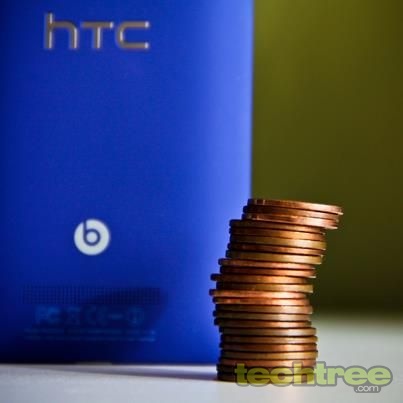
Special Mention: Laughing At Oneself
...But Microsoft finally showed us that it can laugh at its own shortcomings. Internet Explorer is not everybody's favourite browser, and MS knows that. In its latest iteration, IE is trying to catch up with its competitors. This YouTube ad tries to warm you up to reconsider things and go back to IE10. Even though you may not want to walk that road again, the advert does make you smile.
Mobile Phones, Tablets, Sat Nav, Amazon, Apple, Google, Motorola, Nokia, Micromax, Microsoft, Kindle, iPhone, Lumia, 2012 Special, Kamakshi
2012 TechTree Wrap-Up Part 9: Six Commercial Tech Hits
The most happening tech success stories of the year.
-
Jayesh Limaye
08th Jan 2013
- Another iPhone, this time a little longer.
- Microsoft attempted to reinvent the wheel — and succeeded.
- Love it or leave it, Samsung's flagship handset sold the most.
- One of the best games in the FPS genre just got better.
- A faster iPad, well received.
- ...And the rise of the "mini"s.
Read on for our take on why these six are the top successes of 2012.
Apple iPhone 5
Apple launched the iPhone 5 after months of speculations and rumoured launch dates. With a longer, 4" screen (as against the earlier 3.5"), this is the lightest and thinnest iPhone to date. The width is the same, making it perfect for one-handed operation. Powered by the A6 CPU, this is the fastest iteration as well, and it runs the latest iOS 6. And it seemed like a runaway success too: Over 5 million units were sold in the US within three days of launch. In India, despite steep pricing, Apple devices have always been well received. The initial sales streak, however, was reportedly hampered by a delay in supply.Microsoft Windows 8
Microsoft released Windows 8 for desktop computers in October. With a radically new, touchscreen-inclined UI, it was initially difficult to gauge whether the new OS would catch consumers' fancy — given a seemingly steep learning curve. However, underneath the touch interface, the trusted old desktop is available, so users get the best of both worlds. Windows 8 managed to sell 40 million licenses in a month, which is a lot better than any earlier iteration of Windows.Samsung GALAXY S III
It's been ridiculed for its screen size ("too large for a phone"). It's been criticised for lack of innovation in design. However, the Samsung GALAXY S III remained unfazed, emerging as the most successful smartphone of 2012. Upon launch, this flagship device had one of the most powerful hardware configurations as far as smartphones are concerned. Whether or not that led to any real-world benefit is a point of argument. Another reason that it did so well is the cheaper-than-iPhone-5 price tag and the unrestrictive Android OS. A possibly important contributing factor to its success is Samsung's popularity, merely by virtue of being all over the smartphone space!Call Of Duty: Black Ops II
COD: Black Ops II is the ninth instalment of the very successful first-person shooter video game franchise. It continues from where it left off in COD: Black Ops. Set in the year 2025 with a new Cold War between China and the US, it involves robotics, cyberwarfare, and other futuristic technology. As with its predecessors, there are single-player, multi-player, and cooperative modes. Along with the option to play in stereoscopic 3D, this is the first game in the COD franchise to feature nonlinear gameplay and allow multiple endings that depend on the choices a player makes as the game progresses. Developed for PC, Xbox 360, PS3, and Wii U, the game broke the sales record of COD: Modern Warfare 3 by grossing $500 million within 24 hours — and then going on to sell 7.5 million copies by the end of November, which was three weeks since its release. In fact, it sold over a million copies on the first day of availability!Apple iPad (4th Generation)
The iPad was already popular, with one study even showing that an overwhelming majority of internet traffic via tablets is attributed to this device alone. Though not revolutionary, Apple managed to keep things exciting with the 4th generation of this device, with a faster A6X CPU. The new processor promised performance up to two times faster than its predecessor, while maintaining the battery life of 10 hours. This iteration also brought along the 5 mp iSight camera with FaceTime HD camera, improved LTE compatibility, and the new Lightning connector. Its 9.7" Retina display sets it apart from the pack. No wonder it sold 3 million units over just one weekend!Apple iPad mini and Samsung GALAXY S III mini
Not every one looks for larger screens on their gadgets — there is a definite consumer segment that prefers compact devices. Unlike in the smartphone arena, where phablets seemed to be the flavour of the season, Apple and Samsung launched the mini, or shrunk-down, versions of the iPad and GALAXY S III respectively to keep this segment happy.While it is smaller than its sibling, the SGS3 mini — with a 4" Super AMOLED screen running Android 4.1 (Jelly Bean) — is still a powerful device with a dual-core 1 GHz CPU and 1 GB of RAM. It even looks almost identical to the SGS3 (which has a 4.8" screen), save for the smaller dimensions.
Apple didn't bring out a smaller version of the iPhone because the company considers the size apt for a cell phone. However, as they mentioned in their keynote, the iPad mini with a 7.9" screen is supposed to do everything that the larger iPad (with a 9.7" screen) does — except that this device can be held in one hand (assuming the hand is large!). It is still larger than most 7" Android tablets, and definitely more versatile due to the App Store, which is qualitatively better than app markets on other platforms.
Mobile Phones, Tablets, Gaming, Software, Apple, iPhone, iPad, Microsoft, Windows, Samsung, GALAXY, 2012 Special, Jayesh
2012 TechTree Wrap-Up Part 8: Five Tech Flops
Sometimes, what didn't work is as newsworthy as what did!
-
Jayesh Limaye
08th Jan 2013
- A foolhardy way of killing the competition.
- A new smartphone that nobody wanted.
- Promise of speed not quite delivered.
- Cool laptops killed by price.
- "Like" becomes a cardinal sin.
So these are the five flops that stand out in our books. Read on!
1. Apple Removes Google Maps And YouTube
This year saw Apple beginning to remove, from its devices, anything and everything Google-related — including YouTube and Google Maps. The reason? Google owns its arch rival, the Android mobile OS. However, the move backfired as there was no real alternative for either YouTube or Google Maps. Google was quick to release a YouTube app, so users didn't get to feel the heat. However, the iPhone-maker remained adamant with regards to Google Maps, replacing it with Apple Maps when the iOS 6 update came out. The Google Maps app was eventually released a few weeks ago, but the delay was long enough to reveal the significant deficiencies of Apple Maps. These ranged from rendering issues to outright inaccurate location results.2. The Flagship That Wasn't: Nokia Lumia 900
Nokia, the once-number-one manufacturer of mobile phones, decided to go with Windows Phone in a big way last year — with a partnership with Microsoft. It did find some success with the Lumia 800 and Lumia 710 smartphones. The Lumia 900 was, however, a misadventure. The launch happened in the US on Easter, and there were simply no shops open for the phone to be sold. It came with Windows Phone 7.5, while the next big version (Wndows Phone 8) had already been announced. Basically Nokia launched a smartphone based on an older platform, charged a premium over the existing model, and did not add significant features to make it worth the premium. A flop in our books — especially considering that the Lumia 900 did not even reach Indian shores. More recently, of course, Nokia redeemed itself with the Lumia 920.3. 4G In India
Even while parts of the country don't get proper 2.5G speeds, let alone 3G, the next standard — 4G — was announced in India. Many sections of the media, and enthusiats alike, hailed the development, but it turned out to be a bit of a damp squib — after it was found that these 4G plans were only for use with data cards. Most devices that operate on 4G LTE (a standard used in the US) are incompatible with the 4G standards that have been adopted in India (which actually happen to be newer and better). On the upside, newer devices will be able to use the 4G standards here. (On the downside, it's a flop for now.)4. Ultrabooks, Ultraprice?
Whatever the statistics may say about urban India's disposable income, the mantra of "cheap and best" still works. Little wonder, then, that Intel's Ultrabook platform has not taken off here. Concept-wise, it is appealing: Ultrabooks are smaller than conventional notebooks, and may sometimes be as small as netbooks with screen sizes as low as 11". They are thinner and lighter than regular laptops, but are usually just as fast (if not faster). SSD storage and specialised low-power Intel processors in a unibody chassis are typical features of this class. Announced and launched in the US in 2011, it arrived in India only in 2012 (which is why it figures on this list). The device category is not a flop per se, but sales in India have been.5. Freedom On The Internet
This one needs no explanation. The blatant abuse of Section 66A of the IT Act has all of us worried; it's a major flop as far as governance and the spirit of democracy is concerned. But there's some solace in the fact that, while the law remains open to misinterpretation, the government has made it mandatory to get prior approval of the Inspector General of Police (in metros) or the DCP (in urban / rural areas) before using this section to take action against anyone.
Mobile Phones, Laptops, Government, Telecom, Intel, Apple, YouTube, Google, Nokia, Lumia, 2012 Special, Jayesh
2012 TechTree Wrap-Up Part 7: Why Indian Sites Got Hacked
In an upside-down world, lawmakers get jeered and site-breakers are (sometimes) cheered.
-
Kamakshi S
23rd Jan 2013
2012 has been a year of protests across the country, and not without reason. While commoners stuck to shouting slogans and holding placards (for the most part), hacking groups were busy defacing the websites of the alleged "bad guys". One of the more famous groups calls itself Anonymous. Boasting of their exploits via Twitter, the hacktivist group has been in the news over much of 2012. Here's a look at their more infamous hacks through the year in India.
Time To "Trash The Current Government"
In May, Anonymous took down the site of the Indian National Congress as a protest against web censorship. This was after Indian ISPs banned The Pirate Bay and Vimeo. In retaliation, Anonymous also took down the websites of the Supreme Court of India and the All India Congress. In true Anonymous tradition, they posted on their Twitter account: "Namaste India, your time has come to trash the current government and install a new one. Good luck."Dangerous Ishq More Dangerous Than Anticipated!
Soon after "attacking" government and SCI websites, Anonymous' India operations took down Reliance Big Entertainment's (RBE) website along with that of the BJP. Relaince ADAG had initiated a lockdown on sites such as The Pirate Bay and Vimeo to curb piracy on its dud, Dangerous Ishq. Too bad the film didn't do well; if it had, the faces of Reliance ADAG would've at least been worth all the effort.Twitter Blocks Handle, Anonymous Fights Back With A New One!
After Twitter pulled down the group's @opindia_revenge handle, Anonymous — instead of attacking the microblogging service — defaced Goodgov.in, which talks about setting up a new governance model. This was the first instance where they not just attacked a website but defaced it, with warnings of more attacks. Twitter later restored the group's original handle.Opposition-Bashing
In May, Anonymous downed BJP Mumbai's website and the parent BJP website, with a message and a nice background score. This was in retaliation for the opposition not having done anything to curb the government's web censorship policies.The defaced message read, "Today they took away your right to use a few websites... day after tomorrow they will take away your freedom of speech and no one will be there to speak for you. Speak Now or Never".
Mizoram Government Websites Fall
In a bid to mobilise students from the north-eastern states of India to protest against internet censorship, Anonymous blocked several websites of the Mizoram government. A tweet related to this call for action said, "Indians from Mizoram are expected to wake up!! We want an protest organized there too..".Mamata Didi Gets B*t*h-Slapped
Kolkata CM Mamata Banerjee was soon in the line of fire online, and for good reason: After calling students extremists, celebrating like crazy without a real reason (read: Kolkata Knight Riders winning the IPL), lathi-charging cricket-crazy Kolkata fans, and putting a chemistry professor — who drew an unflattering caricature of her — behind bars, Anonymous decided to teach her a lesson. Not by pelting stones; they took down the All India Trinamool Congress (AITMC) website, redirecting users to the group's Twitter page instead. They said in a tweet: "Please spare aitmc.org the horror | No wait she called students asking queries--> maoists !! #OpIndia #Anonymous".Peaceful Protests
The group also staged protests against internet censorship on 9th June. Small groups of netizens donning Guy Fawkes masks were seen in cities including Bangalore, Mangalore, Kochi, Chennai, Vizag, Delhi, Mumbai, and Hyderabad. The Facebook page of the group's Indian arm set up event pages to rally interested individuals. But the month to come showed that the protests weren't as successful as was expected, as it couldn't manage to create enough awareness.The Samajwadi Party Site Goes Down
After lying low for a few months, Anonymous got back into action to take down the Samajwadi Party's site. Facebook and Twitter were being blamed for spreading rumours that caused panic among people of northeastern origin. Rajya Sabha SP leader Ramgopal Yadav, in his infinite wisdom, called for a ban on all social websites. In retaliation, Anonymous took down the SP's site.Don't Want False Claims
While Anonymous prides itself on being internet vigilantes of sorts, the group made it amply clear — in two separate incidents — that they would not take credit for hacks they didn't cause. First there was a DDoS attack causing a DNS outage on GoDaddy.com. The hack was claimed by Anonymousown3r, which Anonymous said was unendorsed by the group: "(It/he) is misguided, or he's trying to give Anons a bad reputation", @AnonyOps tweeted. Closer to home, the hacker group threatened tech portal ThinkDigit.com for incorrectly linking them to an attack on Dominos India's site. After being asked to issue an immediate apology or "face the wrath of Anonymous", the tech site duly complied.Anonymous Takes On Kapil Sibal!
Kapil Sibal, our Union Telecom Minister, has had several foot-in-mouth moments, at least as far as his technology quotes go. In view of his remarks on Section 66A of the IT Act, Anonymous dubbed him a threat to online freedom, defaced his home page, and added this text there: "Kapil Sibal is the world's biggest retard. Born with a below 60 IQ he thought he could mess with the Internet and let the elite of his party suppress freedom of speech."The Year Ends With A Communication Snag
...And for the year-end party, Anonymous picked national telecom company BSNL's site to protest Section 66A of IT Act, instead of going after a politico or industrial biggie. Supporting cartoonist Aseem Trivedi and journalist Alok Dixit, who were on a hunger strike, the defaced BSNL homepage read: "Hacked by Anonymous India, support Aseem trivedi (cartoonist) and alok dixit on the hunger strike, remove IT Act 66a, databases of all 250 bsnl site has been deleted.............Do not think of BACKUP". Why they picked BSNL is a puzzle, though.Looking forward to 2013, let's just hope Anonymous gets fewer reason for such protests.
Security, Internet, Anonymous, Culture, 2012 Special, Kamakshi
Top 5 Sub-Rs 20,000 Smartphones Of 2012
Sifting through numerous smartphones launches this year, we pick five available models within the 20k budget.
-
Chandrakant 'CK' Isi
07th Feb 2013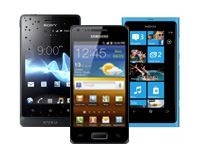
Santa Claus is a nice fantasy, but unless you have rather generous friends or family, you've got to buy smartphones by yourself. If budget isn't a constraint, we might have said pick either the iPhone 5 or the GALAXY S III (or even the Lumia 920, had it been available), depending on which camp you belong to. Since budget matters to most of us, this Top 5 listing comes your way. If Rs 20,000 is your cut-off (it does seem like a nice round number) then this is a must read list. Note that this list is not in order of ranking, but according to their price tag. For a segment dominated by Android, thanks to Microsoft's Windows Phone platform, there's now a bit of choice.
BlackBerry Curve 9320
Street Price: Rs 14,200
The smartphone market is undoubtedly dominated by touchscreen phones. For heavy texters though, QWERTY handsets are still the weapon of choice. And when you decide to pick a QWERTY, it's almost impossible to overlook BlackBerry. The Canadian manufacturer's Curve 9320 features BlackBerry's OS 7.1, which is a significant improvement over the earlier version. The device is sturdy and has a clean design. While the company hasn't disclosed the information regarding its chipset, whatever that's ticking inside does enough to deliver smooth UI. You also get a 3.1 mp camera, which is average. The selling point of course is its well laid keypad, while BlackBerry Messenger (BBM) adds more value to the package. Moreover, its battery life is certainly better than similarly-priced Androids. So if you're keen on joining the BlackBerry boys, the Curve 9320 is the handset to go for at its price point.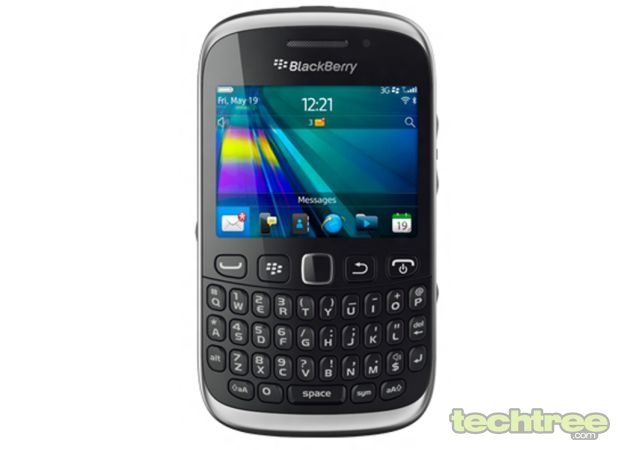
HTC One V
Street Price: Rs 17,500
Amongst other things, HTC phones have a reputation for looking good, and the One V is no exception. With this model, HTC has brought back the iconic curved "chin" design, which is reminiscent of the world's first Android phone, the HTC Dream. Moreover, it's one of the few handsets from top manufacturers to feature Android 4.0 (Ice Cream Sandwich) in this price range: Yes, many smartphone still ship with the outdated Gingerbread. The handset's 1 GHz CPU might sound underwhelming, but it delivers quite a smooth UI. The 3.7" screen, with pixel dimensions of 480x800, is crisp. The 5 mp feature packed camera delivers decent photographs. Overall, at Rs 17,500, this phone is a great deal for Android enthusiasts.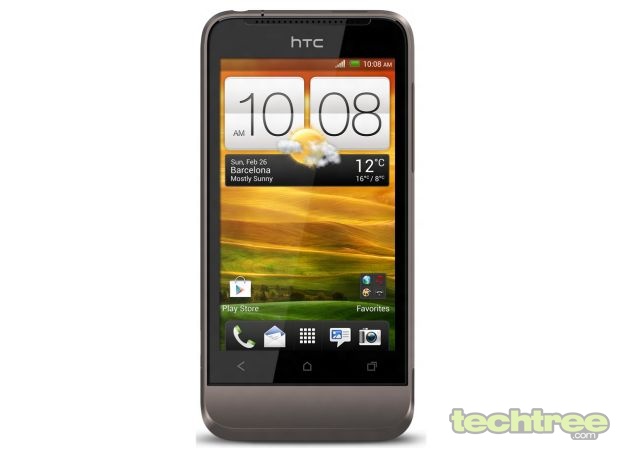
Sony Xperia go
Street Price: Rs 17,500
If you think water-resistant phones are ugly, then you haven't seen the Sony's Xperia go. It's a sleek, trendy phone meant for the outdoor types. It's an IP67 (Ingress Protection 67) compliant phone — here, 6 refers to total protection against dust particles, and 7 refers to the gadget's ability to withstand water immersion (max. 1 metre). The Xperia go is powered by the NovaThor chipset, which is made up of a dual-core 1 GHz Cortex-A9 CPU and Mali-400 GPU (nothing super-fast, but gets the work done). Apart from that, you get a decent 5 mp camera and great sound quality. While it comes preloaded with Android 2.3 (Gingerbread), the manufacturer has rolled out the ICS update.
Nokia Lumia 800
Street Price: Rs 18,300
The Lumia 800 is one of the most beautiful handsets in the market, thanks to Nokia's build and an AMOLED screen with ClearBlack wizardry. With a single-core 1.4 GHz CPU and 512 MB of RAM, the specs may not be very impressive, but the phone delivers a fluid user interface. The 8 mp camera with Carl Zeiss optics give it an edge over the competition. The social networking experience is great, and the voice guided satellite navigation is another plus. After a recent price cut, the phone is now available for around Rs 18,000, and a few online stores are giving away a Purity headset to further sweeten the deal.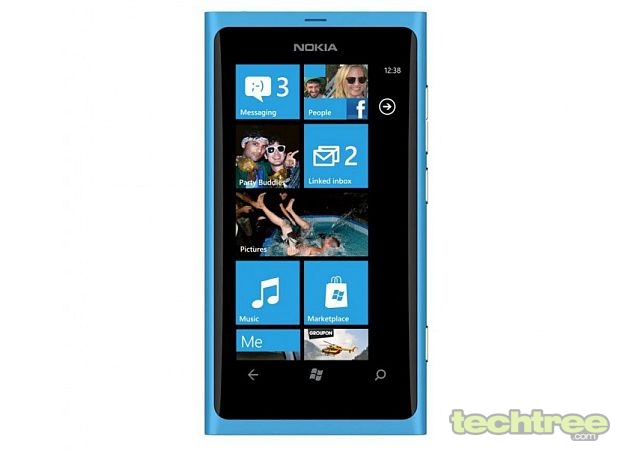
GALAXY S Advance
Street Price: 19,000
It's difficult not to include a GALAXY device on a list of smartphones. Since the GALAXY S II's price is refusing to go below Rs 25,000, the best Samsung phone under 20 grand is the GALAXY S Advance. It features an impressive 4" Super AMOLED screen with pixel dimensions of 480x800. The show is run by the STE U8500 chipset featuring a dual-core 1 GHz Cortex-A9 CPU, coupled with Mali-400MP GPU: Enough fire-power to take care of most Android games. The 5 mp camera is capable of recording HD video. Moreover, you have a 1.3 mp front facing camera for video calls. The GALAXY S Advance features Android 2.3 (Gingerbread), and is expected to receive the Android 4.1 (Jelly Bean) update in January.[Note: this listing is in the order of pricing and is not a ranking]
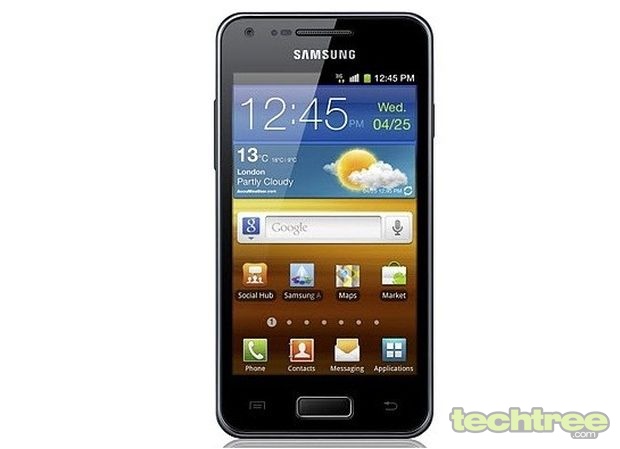
Mobile Phones, Android, Windows Phone, HTC, Nokia, Samsung, Sony, 2012 Special, Buyers Guide
Nokia Lumia 920 — Is Nokia Back In The Game?
The idiomatic million dollar question in the smartphone market is, has Nokia managed to bring a worthy entrant to the smartphone war currently waged by Apple and Samsung?
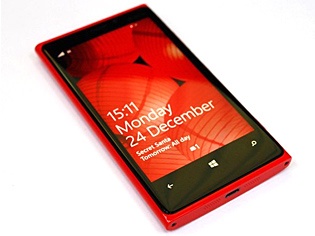 Pros:
Pros:
Sturdy Build; Beautiful design; Camera gets optical image stabilisation and does well in low light; Extremely responsive touchscreen; Sleek and fluid UI; Voice-guided sat nav that actually works; Rich social networking experience; Crisp display; Great sound quality.Cons:
No significant cons; Given the bulk, the battery life could have been better.Nokia Lumia 920
Street Price: Approx. Rs 35,500
Nokia's partnership with Microsoft could have gone either way; industry observers have been divided in opinion. Nokia's recent flagship devices have posed no real threat to the iPhone 4S / 5 and the myriad of Androids. But things look different now, with Windows Phone 8 and the latest high-end smartphone, the Lumia 920. Unlike Nokia's earlier top-of-the-line Windows Phone handsets, the Lumia 920 seems right from the word go. The spec sheet includes PureView camera tech, the tried-and-tested Snapdragon S4 chipset, PureMotion HD+ screen with high refresh rate, wireless (induction) charging, and more.
Review units were not available from Nokia at the time of launch, so we obtained one from the Netherlands.
The Bold And The Beautiful
There are no prizes for guessing that the Lumia 920 looks like an overgrown Lumia 800 — but that's not necessarily a bad thing. The phone's body is CNC-machined; each device is carved out of a single polycarbonate block. The result is a seamless unibody with no cuts or joints, save for the ports and buttons. The precision build and attention to detail is simply amazing. Another advantage of the coloured polycarbonate is that even if you manage to chip off a chunk from the Lumia 920, it will reveal the same colour underneath. This means you won't have to worry about your phone losing its colour.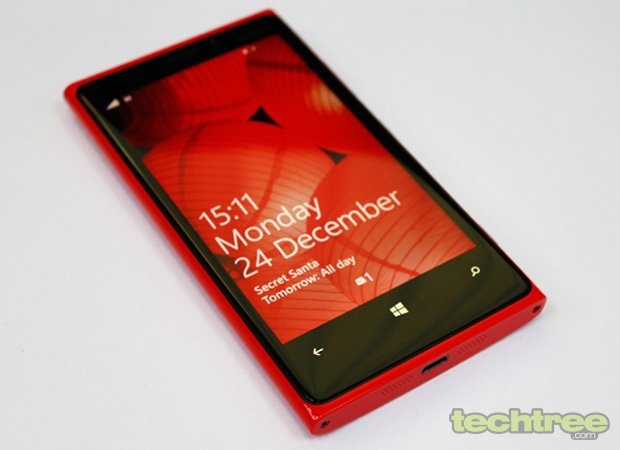
With the Lumia series, Nokia brought back bright colours into fashion. HTC tried something similar with its Windows Phone 8X, but after seeing them both, I'd say the 920 is strikingly beautiful. Apart from the bold red (the piece we reviewed), yellow and white models sport a glossy finish. On the other hand, black, grey, and cyan (currently US exclusive) are matte.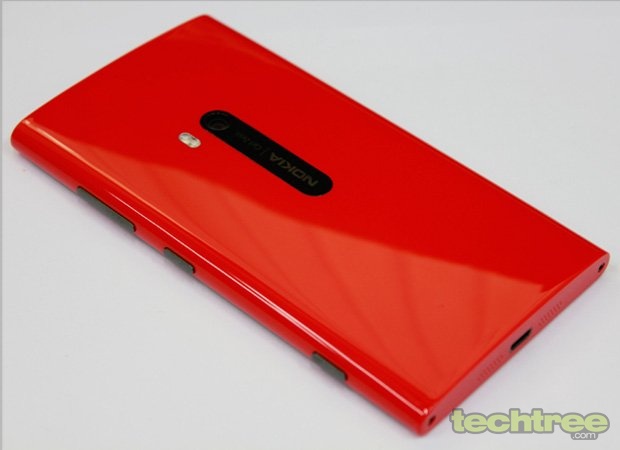
After skipping the Lumia 900, the curved display is back with the 920, complementing the design. The use of metal near the 800's camera lens was tasteful, but with use, I found that it's prone to scratches. In the case of the Lumia 920, though, Nokia has retained the placement, replacing the metal with ceramic zirconium (the toughest ceramic commercially available). Nokia claims that this material is both scratch- and wear-resistant.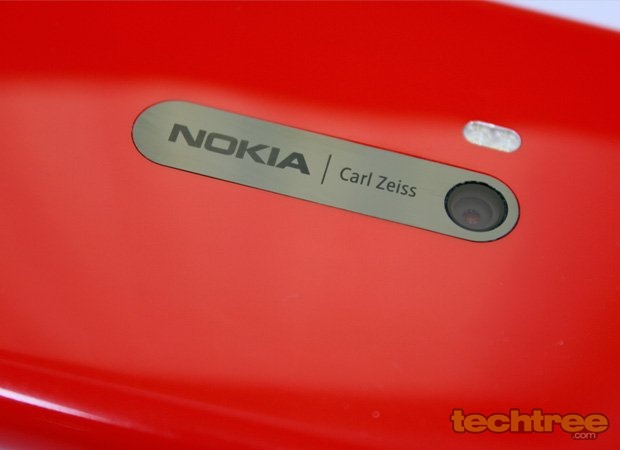
Instead of concentrating on merely slimming down the device, Nokia has been looking at ergonomics. The phone is thick, but due to its curved edges, it fits comfortably in your hand. Weight-wise, it's on the heavier side at around 185 grams.
Display
The handset features a 4.5" IPS screen labelled as PureMotion HD+ display by Nokia. The display's 1280 x 768 pixels offers a 15:9 ratio that neatly scales the old WP 7.5 apps in right proportion edge-to-edge. On the other hand, the HTC 8X with a 16:9 screen runs some older apps with a thin letterbox (vertical bars that are used to fit images of one aspect ratio onto a screen of a different aspect ratio).
The 920's screen has a pixel density of 332 ppi, which is in iPhone 5 territory (325 ppi). Sharpness is not an issue; thanks to the high 60 Hz refresh rate, anything that the screen displays — be it scrolling text or fancy transitions — looks good. Being an IPS panel, the screen offers wide viewing angles.
Nokia's ClearBlack technology, consisting of a sequence of polarising layers, eliminates reflections and delivers sunlight legibility. The screen also offers better contrast ratio than most IPS panels. The levels of blacks on the 920 are comparable to AMOLED panels, except when set to full brightness. While it's one of the best IPS panels I've seen on smartphones, I would have preferred an AMOLED screen on this phone.
There's been a lot hype surrounding Nokia's super-sensitive screen. After using the phone for a few days, I can confidently say it's one of the most responsive touchscreens available. Just like the iPhone 5's screen, it never missed an input. Even better, it's operable with pen, gloves, keys, fork, fingernails, and even a nail! This ability can come in handy in the northern parts of our country, where gloves are a must in winter. Finally, like any other high-end smartphone screen, this one is protected by Gorilla Glass 2.
Package, Basic Specs
There's nothing special in the Lumia 920's retail package. You get a USB cable, charger, and IEMs that match the colour of your of handset. But wait, where's my charging plate, Nokia? Too bad — it has to be bought separately.The phone is powered by Qualcomm's Snapdragon S4 chipset, featuring a dual-core 1.5 GHz CPU and Adreno 225 GPU. It has an 8.7 mp camera with dual-LED flash, Carl Zeiss optics, and Optical Image Stabilisation. Apart from that, you get a 4.5" IPS panel with pixel dimensions of 768x1280, 1 GB of RAM, and 32 GB internal storage. The detailed list of specs is at the end of this review.
Windows Phone 8 With Nokia Exclusive Apps
With support for multi-core CPUs, the Windows Phone platform now performs even better. Thanks to a Snapdragon S4 chipset ticking inside the 920, the experience is as smooth as that of the iPhone 5. As already mentioned in oooour review of the HTC 8X, Microsoft has removed the unused space, often referred to as the gutter, from the homscreen. Users can now customise Live Tiles with three sizes to choose from. Other functionality upgrades include the addition of the mass storage mode and Bluetooth file sharing.
Kid's Corner, as its name suggests, lets you create a separate homescreen with restricted access for children. This way, you can also let other people check out your cool new phone without compromising your privacy. Minor changes include an improved lock screen that can display updates from apps, and pull background images from Bing and Facebook feeds.
One of the things I didn't like about HTC's 8X was its lacklustre maps app. In the 920's case though, you have the tried-and-tested Nokia Drive. The app allows you to download map data right on the device. Nokia offers maps for most countries; additionally, there's an option to download map data for an entire country as well as for individual states. For example, you can install the India (All) map, which is 553 MB in size, or opt for the Maharashtra/Goa map, that fits into 131 MB. Once you've downloaded the desired maps, you can avail free voice guided navigation in offline mode. The app is packed with features, and there's even an option to get voice instructions in many languages — including Hindi. The device's GPS performance is impressive; even in offline mode, it never took more than two minutes to lock onto satellites.
To top it off, Nokia offers an AR (Augmented Reality) app called City Lens that lets you find places of interest in a given locality. It helps you "see" where restaurants, theatres, train or bus stations, and shops are. It's like having HUD (Heads Up Display) in real life. What's more, it also displays the name of most residential buildings (at least in Mumbai)!
PhotoBeamer is another interesting app from Nokia that allows you to display your pictures on any web-enabled device. Fire up this app, and open the image gallery on your phone. Then visit photobeamer.com on a device where you wish to display the photograph, and simply point the phone camera at the QR code that appears on the website. The photos on your device get mirrored on the other device instantaneously. It's the fastest and easiest way to share your pictures on a bigger screen.
Coming to the subject of apps, Microsoft's Office Suite is impressive. The mobile version of IE10 is blazing fast at page rendering. If you own an Xbox 360, then Smart Glass is a must have app: It not only works as a controller for your console, but also comes in handy for text input. Bing is no match for Google, agreed. However, Bing Vision feature on Windows Phone is superb. Using the phone's camera, this app can scan QR codes, UPC codes, and even album art to provide additional information. My favourite feature is its ability to scan and translate one language to another within seconds. If you're in China, you can at least read billboards using this functionality.
Microsoft's Store, previously known as Marketplace, has around 125,000 apps, and is getting busier each passing day. As far as I'm concerned, most of the essential apps are available for all platforms anyway. Still, going by sheer numbers, it has a long way to go before catching up with Apple and Google's app repositories.
Multimedia
WP8's default music player offers a neat and clutter-free interface, but there are no equaliser settings. Nokia's Music app however does offer equaliser settings, and also comes with Dolby sound enhancement. The device's sound quality is great, and the bundled earphones are of good quality too. Just like the HTC's 8X, the Lumia 920 lacks FM radio (surprisingly, Nokia's official blog confirms that the FM tuner is present on the phone; we'll update when we have a clarification). The Snapdragon S4 takes care of MP4 and AVI videos up to 1080p — but MKV videos are still a no-go.Camera
The 8.7 mp camera on the Lumia 920 isn't the fastest one around, but it's definitely one of the best. It offers Lenses, which are actually photo apps that can be integrated right into the camera's UI. For example, a lens app called Smart Shot captures multiple photos and then allows you to choose and save the best one. There's an option to tap on a face and pick the frame where the person hasn't blinked. What's more, you can even delete a stranger who accidently walked into your group photo. Check out the screenshots below to see how it's done.
With Cinemagraph you can animate certain parts of an image. In simple words, it's like those animated photographs you can see in Harry Potter And The Prisoner Of Azkaban. For best results, you need the most basic photography skill: Steady Hands. Once you click the photo, the software gives you areas that can be animated. If you're not happy with those suggestions, you can select the desired portions manually. Click here to view a sample.
Panorama is duly covered, and it does what it says. Its interface is better than what competing Android phones offer, yet it isn't as intuitive as the iPhone 5's panorama app. Check the gallery below for panorama and outdoor photography samples.
The Lumia 920 is capable of recording 1080p videos at 30 fps.
Most cellphone cameras (for that matter, point and shoots too, generally) falter in low light. The Lumia 920 does better here, thanks to OIS (Optical Image Stabilisation), which allows for a longer shutter duration without risking blur caused by shaky hands. We did a quick low-light test of this Lumia against today's most popular Android, the GALAXY S III, and here are the results:
Low light photo comparison (without flash).
Telephony And Messaging
People Hub is one of the selling points of WP handsets. Thanks to deep social networking integration, you can access all your contacts from Facebook, Windows Live, Twitter, and LinkedIn in one place. What's more, the soft keyboard is extremely responsive and is designed to minimise typos. Finally, the Lumia 920's network reception and call quality were good during our tests. (Do note that these tests are quite subjective.)
Battery
The phone packs in a 2000 mAh Li-Ion battery. In our 720p video loop test, it lasted around 6 hours and 30 minutes. Not spectacular, but better than the GALAXY SIII's 5 hours and 30 minutes. The fatboy pillow works as advertised — just place the Lumia 920 on it, and see your phone take a power nap. While it's not a necessity, it makes charging very convenient.
Verdict
The Lumia 920's success is important for Nokia to get back in the smartphone arena. The company has put in a lot of effort, and it shows. Bold colours, beautiful design, and the outstanding camera set it apart from the current crop of smartphones. The UI is as fluid as iOS, and the number of features can be compared to that of any flagship Android phone. In short, with the Lumia 920, the Finnish manufacturer has delivered both style and substance.
Features: 5/5
Design And Build Quality: 4.5/5
Performance: 4.5/5
Value For Money: 4/5
Mojo: 5/5
Overall Rating: 4.5/5- 4.5'' PureMotion HD+ IPS panel with pixel dimensions of 768x1280 (332 ppi), Corning's Gorilla Glass protection, 60 Hz refresh rate, Polarization filter, 600 nits of luminance.
- Dual-core 1.5 GHz Snapdragon S4 chipset, 1 GB of RAM.
- 8.7 mp auto-focus PureView camera with dual LED flash, Carl Zeiss Tessar optics, 1080p video recording.
- NFC, Bluetooth 3.1, Wi-Fi with hotspot support, GPS with offline navigation.
- 32 GB internal storage, 7 GB in SkyDrive (cloud storage).
- 2000 mAh battery, 17 hours of talk time for 2G (10 hours for 3G), 67 hours of music playback, 6 hours of video playback.
- 3.5 mm jack with Dolby sound enhancement, Micro-USB port.
- Micro-SIM, Quad-band GSM (850, 900, 1800, 1900 MHz), Quad-band 3G (850, 900, 1900, 2100 MHz), Penta-band 4G LTE (800, 900, 1800, 2100, 2600 MHz).
- Windows Phone 8.
TAGS: Mobile Phones, Windows Phone, Nokia, Lumia, ck

2012 Techtree Wrap-Up Part 5: Internet Stars Of The Year
From movies to people, Google and Facebook's data reveals what India did for online this year.
-
Chandrakant 'CK' Isi
07th Jan 2013
[With inputs from Kamakshi S]
The Year End party is just around the corner, it's fun to look back at what was big on the net in 2012. And what better way to gauge than what the internet giants, Google and Facebook have compiled? We sifted through Google's annual Zeitgeist report, and Facebook's data compilation to figure out what billions of people were looking for through their phones, tablets, and PCs.
To keep things more specific, Google has filtered out generic terms such as free, games, and music, and Facebook has published only a list of check-ins and music. Some of these are interesting (and you might even see yourself sheepishly agreeing to many!). So make your self a big a tub of popcorn as we begin dissecting the depths of the web!
Most people who use web searches and social networks are deemed to be literate, they don't necessarily need to be educated or civil for that matter. Google's data opens the doors to India's proverbial closet: But nothing that should surprise you out of your skin. The most searched person in the country is a porn star, Sunny Leone. If that isn't surprisingly enough, the "honourable" third position is taken by Poonam Pandey — a model and Twitter celeb who announced she would strip in public if the Indian cricket team won the World Cup 2011. Seventh on the list, Sherlyn Chopra, Playboy's Indian debut, seems to be more widely anticipated that most people would admit in open. It is however quite an achievement for a nation that never fails to uphold its double standards with sexuality, under the guide of "culture" and "traditions". Next year, maybe Google should replace the "I'm Feeling Lucky" button with "I'm Feeling Horny", just for India.
Moving on to Bollywood, Ek Tha Tiger, one of the worst films I've seen in my life, tops the search list. My hopes sank further looking at the rest of the movies that make up the top ten: Jism 2, Raaz 3, Jannat 2, Housefull 2, Rowdy Rathore, and Agent Vinod — each with a worse plot than the other. Nobody seems to have searched for movies like Paan Singh Tomar, or even Kahaani for that matter. The inspired-from-several-sources-yet-India's-Oscar-entry film Barfi, also seemed to make it to the most searched movies list: probably people were curious to know what sources it picked up from.
Amongst the bookish types, IBPS (Institute of Banking Personnel Selection) and GATE (Graduate Aptitude Test in Engineering) were the two most popular terms, in that order. Looks like the youth has still its heart set on government jobs, and our country seems to have no shortage of engineers either. In this "all inclusive" search list, Aakash tablet took 8th spot, just below the late superstar Rajesh Khanna. Surprisingly, it's the only gadget that made it to the top ten list. Looks like students have bought into the idea of being virtually gifted a tablet. The other entry that took me by surprise was Jabong on the 10th spot. Seems like people are warming up to buying apparels and accessories and not just gadgets online. I wish they come up with better, more tolerable television commercials though!
If one were to judge Indians based on this data, the conclusion would be that Indians want to become clerks, love porn stars, and have too much time to watch and bad movies.
But that's just us. In worldwide search results, topping the list was Whitney Houston, well-known American singer and model who was found dead in her bathtub in February. The way I see it, it shows how people are incredibly curious: Everybody wants a piece of juicy gossip; it doesn't matter if it's the next-door-neighbour or a washed-up star from the yester years. The second most trending query was Gangnam Style. Again, the world at large seems to have no love for good music, but if you pit him against the likes of viral starlets Justin Beiber and Rebecca Black, PSY can atleast sing to save his life, and can even shake his leg a bit (it's another matter than I find it annoying both to the ears and the eyes). On a positive note, Olympics 2012 made it to the seventh place, but cricket-crazy Indians didn't give a damn despite this being our best performance at the games ever! While netizens back home swooned over a dirt-cheap Android tablet, the world went gaga over the iPad 3, which made it to the 4th spot in the list.
In the list of most searched people, Whitney Houston beat Kate Middleton, Prince William's new wife. Seems like the Americans outplayed British netizens here. Another notable entry is Amanda Todd, a morbid teenager who committed suicide after setting up herself to be cyber bullied. First world problems are beyond my understanding anyway. But my favourite in the list is undoubtedly Felix Baumgartner, the Austrian skydiver, who set the world record jumping from a height of 39 kilometres. Frankly, I think this daredevil act deserved to be placed a lot higher than the talentless English-Irish boy band One Direction.For other lists and more analysis, head over to www.google.com/zeitgeist/2012.
Moving on to the social networking side of the web, Facebook also came up with some interesting year-end analysis, which highlights the world's social mindset in 2012.
The social network didn't shed a lot of light on what Indians did on the service, except compiling a list of most checked in locations and what trended musically. On the music front, songs from movies such as Cocktail, Rowdy Rathod, Janat 2, Jism 2, Student Of The Year made it on top of the charts. Most of these tunes have been inspired (Pritam lent his "worldly music knowledge" to the dud called Cocktail), or are just plain annoying (Chinta ta chita chita? What do they smoke to come up with "gems" like these?). But for a country that considers Kolaveri di a musical master piece, I guess expecting to do any better is too much to ask for. For details, you can go here.
This was the gist of the internet insights had to offer in 2012. Looking at the recent events, and how people are becoming less tolerant and more violent to sensitive issues around them, here's hoping that the revolutionary new year makes netizens a more responsible lot.
Internet, Culture, Movies, Google, Facebook, 2012 Special, ck, Kamakshi
Opinion: Why Sec 66A Must Go?
It suppress thought, kills free speech, ensures that everybody knows that Big Brother is watching and through all of this makes sure there is no dissent in the society.
-
L Subramanyan
24th Dec 2012
History teaches you many things. Amongst them, one that I recall is — you just cannot fight a thought. No amount of repressive muscle can put an idea down. The Indian lawmakers would do well if they keep this in mind.
Sec 66A of the Indian Information Technology Act seeks to do just that: Suppress thought, kill free speech, ensure everybody knows that Big Brother is watching and through all of this, make sure there is no dissent in the society. Fathered by the current Minister of IT, this Harvard educated eminent lawyer has ensured that such a regressive piece of legislation is not only law, but is used by the law enforcement agencies throughout the country by a (largely) digitally-illiterate police force.
Sec 66A, assumes a lot and is open to interpretation depending upon one's mood of the day. For instance, today, somebody posting a picture of herself on her FB page could be deemed offensive, and tomorrow someone who defaces the Indian Parliament's official website may not be. Consequently, you will arrest the girl who is putting her own pictures in her own page on Facebook, but might smile indulgently at those 'boyish pranks' of a hacker. Such is the gamut of this Draconian section.
The Palgarh experience is one that came to the attention of the public. There are coutless instances when people have been summoned to the police station at the slightest of excuses. "Don't like your tweet", here is Sec 66A. Don't like your cartoon of a politician on your own site, here is Sec 66A. Don't like your attitude, file an FIR under Sec 66A and get me arrested.
The Indian cops are delighted. Here is one opportunity they have to get back at those "IT types" who any way do things that these cops don't get. Hence, if I don't understand, slap Sec 66A. Let the courts clear him/her later.
We are not suggesting that it is a free-for-all society. There ought to be checks and balances, but putting in an all encompassing, wide section which can be interpreted in more than 100 different ways, is surely a recipe for disaster — a disaster that continues to happen across the country.
There is no use lamenting that state governments are misusing Sec 66A, as the Home Minister has admitted recently. Give them an object to abuse and they will do so. The solution is to remove that temptation.
For Sec 66A, the only solution is that either it is made very sharp and not open to multiple interpretations, or it must simply go. It is for the government to decide which option they prefer.
Western Digital VelociRaptor 1 TB Review
With an unmatched combination of performance and capacity, this drive gives an SSD the run for its money.
 Pros:
Pros:
Wicked fast speeds; Runs cool during operation; 10,000 RPM.Cons:
Quite expensive; Can be a bit noisy when stressed.Geek Corner: Western Digital VelociRaptor 1 TB Review
MRP: Rs 15,500The Raptor class of hard drives from Western Digital (WD) has attained legendary status like no other, thanks to its extraordinarily high data transfer rates, aided by the spindle rotating at a blistering 10,000 RPM. To put this number in perspective, usual desktop hard drives max out at 7200 rpm (some even slow down to reduce power consumption and increase longevity), and laptop hard drives do 5400 rpm. So, when we say this drive is fast, we also mean it is mechanically fast. When WD created the earlier Raptor species of drives with storage capacity not being a prime consideration - the Raptors started off with a 36 GB and eventually topped out at 150 GB (while 500GB normal hard disks were common). An increase in storage capacity was inevitable, and WD later launched the VelociRaptor with increasing storage capacities, and now in its tenth year of existence, the company has brought out the 6th generation WD1000DHTZ with 1 TB, which is what we have reviewed today. This is the kind of hardware enthusiasts and gamers would be more interested in - the performance is second to only SSDs, but with relatively high capacity (unlike SSDs which are extremely expensive for this kind of capacity). Just like its predecessors, this is a 2.5" form-factor drive sitting on a rather oversized heat-sink complete with radiator fins surrounding it. Let's see if this one can perform well enough to buy instead of an SSD.
Features And Specs
Before getting inot the performance test numbers, here's a quick look at the physical features of the drive. Similar to the earlier version, this drive is peculiar in its design with a 2.5" drive sitting inside a heat sink. That being said, it does not mean that it is a laptop drive; it is compatible with 3.5" PC cabinet bays and can also be used in hot-swappable NAS servers.
Detaching it from the heat-sink is possible if you try, although, doing so will void the warranty. The spoiler-like heat-sink fins goes well with the VelociRaptor name. The IcePack Mounting Frame, as WD prefers to call it, not just serves as a heat-sink, but also as a mounting frame to enable mounting it in any standard 3.5" bay in a desktop chassis. Only a tiny strip of the green circuit board is exposed from below the drive, the rest being hidden.
Being a 2.5" drive, the platters are smaller and more densely packed, thus the very low access time. Featuring the Perpendicular Magnetic Recording technology, each of the three platters packs in 333 GB. The drive spins at the Raptor’s signature speed of 10,000 RPM, which is the main reason for its commendable performance. It comes with 64 MB of cache memory, which is more than sufficient for any task.
The SATA 6.0 Gbps or SATA III interface physically looks just the same as against the SATA 3.0 Gbps or SATA II, and is backward compatible. However, we don't think anyone who buys this drive using it with anything less than a state-of-the-art system with SATA 6 Gbps ports.
Here are some other things that this drive incorporates. Rotary Acceleration Feed Forward or RAFF optimizes operation and performance of the drive when used in a vibration-prone environment such as a multi-drive cabinet or ones with noisy fans or speaker systems around. The drive takes action to preserve data reliability in such case using RAFF. No Touch ramp load technology parks the drive heads off the disk surface during spin-up, spin-down or when the drive is off to ensure that it never touches the disk surface resulting in better reliability and protection to data when the drive or chassis is moved.
Importantly, the drive's MTBF (mean time between failures) is 1.4 million hours, taking it to the level of enterprise-class of hard drives. Such a high MTBF makes this drive all the more reliable and that is always a good thing.
Performance
We connected this drive to the SATA III port of the ASRock P67 Extreme6 with the Marvel SATA III controller using a SATA 6.0 Gbps cable. The properties of the drive in Windows Explorer show up the capacity as 931 GB.
We used benchmarking tools such as H2Bench, HDTach, HD Tune, SiSoftware SANDRA and CrystalDiskMark. We also checked out the performance of the WD SiliconEdge Blue 256 GB SSD for comparison.
H2Bench is a low-level hard drive testing utility and gives an indication of the raw performance of the drive. The drive was not formatted while we conducted this test; it did not hold any file system. The drive returned a score of 271.2 MB/s in the “core test”, which is a good score. In comparison, the 600 GB version of the VelociRaptor returns 199.1 MB/s, while the SiliconEdge returned just 128.4 MB/s.
HDTach RW is yet another low-level test that does not require the hard drive to have a file system.
These are very good scores.
HD Tune Pro is a hard disk benchmarking utility capable of performing low-level as well as file system benchmarks and displaying the result in the form of a graph. We ran the read as well as the write test to measure the transfer speeds, burst speeds, and access time across the entire drive and obtained the results as in the figure.
The results of the HD Tune Pro 5.00 Read Benchmark
And of the Write Benchmark
Note that the temperature of the drive was hovering near just 34 degrees Celsius, which is not high, considering the fact that the room was not cooled and the drive spins at 10,000 RPM.
SiSoftware SANDRA: We created a fresh NTFS partition on the test hard drive and ran the File System benchmark module on the freshly-formatted partition.
The drive returned up an index of 154 MB/s and an access time of just 4 ms. This drive easily goes past every drive we have tested thus far, thus confirming that the VelociRaptor is really the fastest mechanical hard drive as has been hyped.
CrystalDiskMark: This is a benchmark to measure read and write speeds of external hard drives and Flash drives. We have chosen a 1000MB data sample with 5 repetitions to measure data transfer speeds.
We were monitoring the drive temperature during the entire duration of the test and it never went above 34 degrees Celsius, which is awesome for a drive rotating at such high speeds and considering the fact that the AC was switched off. For those with noise considerations, this drive does produce a whirring sound that is something similar to an optical disc spinning at high speed.
Our Verdict
After the dust has finally settled, we were reassured that the WD VelociRaptor 1 TB deserves the unique pole position in the enthusiast segment that it is touted to occupy. We can say from the performance that it is indeed the fastest mechanical hard drive that we have ever come across. The overall performance is 20% higher from the previous version and around than 20% lower than a regular SSD, the SiliconEdge Blue 256 GB, in this case. While SSDs are still ahead in terms of performance, they don't sell well due to their exorbitant pricing. While the WD1000DHTZ also costs considerably higher than a regular 1 TB mechanical hard drive (Rs 15,500 for this beast versus the latter's Rs 4500), its performance places it favourably in ahead of an SSD. Speaking of SSDs, a 256 GB drive costs around Rs 15,000, while a 1 TB version is not even available in India. This drive really has no competition. If you are a gamer or enthusiast who doesn't want to compromise on either performance or storage capacity, then the WD VelociRaptor 1 TB WD1000DHTZ is the way to go. A 500 GB version WD5000HHTZ is also available for Rs 9300, if your budget is under Rs 10,000, and since 500 GB is still good enough for OS and programs to run off on.
Features: 4.5/5
Performance: 4.5/5
Value For Money: 3.5/5
Mojo: 4.5/5Overall Rating: 4.5/5
TAGS: Storage, Western Digital, Geek Corner

India Will Soon Have Its 'Own' Operating System: Reports
Spearheaded by Defense Research and Development Organization (DRDO), the desi OS promises what Linux and Windows allegedly don't have.
-
Rizwan Memon
19:52 24th Dec, 2012
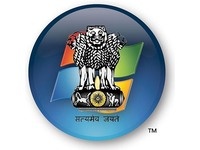
Here's a development that we read about and are quite perplexed with the details of the report. Apparently, the DRDO (Defence Research and Development Organization) has some glorious plans in the making. No ICBM, no nothing. These guys are on to making an 'Indian Operating System' (yes that is what it is named as), providing a rather questionable justification for the project.
DRDO's Director-General VK Saraswat suggests that India is very dependent on foreign operating systems, such as Windows and Linux. The Director-General perhaps does not realise that no one really owns Linux. The concept of foreign vs Indian does not apply to open source software, including Linux. It is entirely possible to take the Linux core and build something extremely robust and strong on top of it.
He added that these (the so-called foreign operating systems) tend to compromise cyber safety and are susceptible to worms and other security issues. Which is why, he claims, it is necessary for India to build its own OS. It would be very surprisingly if our mission critical defence systems are not already running an OS thoroughly tested for security holes. So what is this Indian Operating System supposed to achieve? For common citizens it means nothing - there are plenty of free and robust open source OSes to choose from already, if one is paranoid about digital security. On a related note, India already has a desi OS called BOSS (Bharat Operating System Solutions) with support for Indian languages.If the Indian Operating System is being developed for defence use, sure, that's a different matter. But why are we not already on a secure OS (of whatever platform) ?
Apparently, DRDO has already spent 18 months to develop the OS with 150 engineers working on it. Could these skilled engineers have spent their time on critical tasks, say building systems for intelligence gathering? Judging that is beyond the scope of TechTree, but the answer seems fairly obvious. This "Indian Operating System" (no points for creativity), which will need 3 more years to possibly be ready seems like the desi fad being taken too far.
Saraswat also added that India should also manufacture its own hardware, as currently all transmitter / receivers are being imported. Good. Next, let's take over the world. Then, nothing would be foreign.
TAGS: Security, Government, Humour, Rizwan
2012 TechTree Wrap-Up Part 4: Interest In Televisions Continued To Be High
...because prices kept falling and new technologies got introduced.
-
Jayesh Limaye
04th Jan 2013
While new LED-backlit LCD TVs upped the display quality and 3D in TVs became more common, PC monitors continued to get cheaper still from last year – all this and some more in our round up of displays (especially TVs) in 2012.
LED TVs which were elusive (in India) last year, have now become common. Every television manufacturer out there is in the process of completely replacing LCD models with ones based on LED. Let's clarify that 'LED TV' actually means LED-backlit-LCD TV (yes, the display panel is still good old LCD). Instead of CCFL lighting, you get LED backlight, which results in increased brightness, lower power consumption, and reduced bulk. Apart from brightness, other image parameters are still dependent on the LCD panel. However, most people do find LEDs more appealing than LCDs. Like most new technologies that come to India, this one too was overpriced in its initial days. For example, a 32" LED costs the same as a 42" LCD from the same manufacturer. However, prices are coming down and we suggest you either wait until LED prices rationalise, or buy a larger LCD (despite 'normal' LCDs becoming near obsolete) for the same money. Size, sometimes, does matter.
Plasma TVs continued to co-exist with LCDs / LEDs, but they seem to be a dying breed, a pity since even budget plasma TVs match or exceed expensive LCDs / LEDs with image quality, especially with black levels. Panasonic and Samsung plasma launches saw 3D becoming a de facto feature in most models.
Price cuts that were overdue in our opinion, happened this year, most noticeably with 32" models: Some with Full HD were as cheap as Rs 20,000. TVs with PC monitor-like sizes (19" – 24") made appearance, but that's too small a size for anything but a really, really small room.
Computer monitors 23" and 24" models now occupy the spot that 20"-22" ones did as far as value for money goes. Some 24" models are now within the Rs 10,000 price bracket. If that much money is not unaffordable, we suggest you go for the large size – after all, a larger display is one of the big advantages that a desktop scores over laptops and tablets.
Touchscreens displays are not yet available, although with Windows 8 being launched, we won't be surprised to this feature coming to desktop displays next year. Of course, there are rather inexpensive solutions available for those of you who don't want to wait for that long.
NVIDIA 3D Vision 2, the Desktop 3D, which was launched globally last year finally made it to Indian markets. Die-hard fans of 3D were in for a treat with the brighter display and a remarkable reduction in flickering in 3D mode — a common complaint when it comes to viewing stereoscopic 3D content. Yet again, this technology remained accessible only to a niche segment due to exorbitant pricing — a 24" active 3D monitor costs upward of Rs 20,000 — and also because there is still not enough 3D content available. Passive 3D monitors such as those from LG and AOC are available for around Rs 15,000, but the quality is noticeably inferior as compared to active 3D. In case we didn't mention, 3D continued to be pushed yet again by TV companies even with similar sized 3D models costing up to twice as much as the 2D variants.
More than HD? As if 1080p visuals didn't pack in enough details, this year saw display technology go beyond high definition, pushing the bar higher. The introduction of 3D Ultra-high-definition TVs (UHDTV) supporting 4K resolution is a proof of concept, sure, but we are not placing bets on adoption any time too soon, owing to both, cost as well as lack of content that can utilize the massive number of pixels. 4K basically means that the TV is able to display 2160p content, because its panel has pixel dimensions of 3840x2160, which is twice in height and twice in width to that of Full HD (1080p).
Indians are yet to warm up to Projectors for home entertainment, and this time it is not just about the cost. The viewing room setup is often not conducive to set up a projector and most of us in cities cannot afford to have a dedicated TV room. Globally, while 4K projection made its debut, 3D projection was also pushed by manufacturers in an increasing number of projectors. Like TVs, many projectors now can play videos straight off USB drives.
Which of these display devices is for you? Or do you plan till next year, waiting for them to become cheaper or for newer technologies to appear?
2012 TechTree Wrap-Up Part 3: PC Hardware Takes The Beaten Path
Of ultrabooks, new processors, SSD prices and more.
-
Jayesh Limaye
04th Jan 2013
Has the advent of laptops and now tablets killed the good old PC for good? Many have predicted the death of the personal computer as we know it, and perhaps one day it will become obsolete – or, more likely, evolve into something else altogether. But for now, the PC is staying (even if it is losing market share to laptops). Here's a gist of the PC hardware developments of 2012.
AMD vs Intel, again
AMD built on its Fusion concept in which a basic GPU is combined with the CPU to achieve power efficiency and a lower cost for the user (since motherboards need not have a graphics chip). Recently in September, the company even launched a new socket type called FM2 for their APU chips (technically you cannot call them CPU because they contain more than a central processing unit). This new socket is not backwards compatible.Intel, on its part made its already commendable Sandy Bridge even more power efficient with the new Ivy Bridge, which is basically a die-shrink of the same architecture to the new 22 micron fabrication process, resulting in a claimed 50% lower power consumption. Not the ones to be left behind in the APU development, Intel brought in DirectX 11, OpenGL 3.1, and 4K video playback support in the integrated graphics on-board the CPU. The good news is that these new Core i5 and Core i7 processors are compatible with the existing LGA 1155 socket, thus making it possible to upgrade to them on a motherboard that is a generation old.
As expected, laptops outsold desktops, but desktop fans (yes, such a breed exists) need not fear – like we said, desktops are not going away in the near future. One trend worth mentioning is that, while the recent years saw laptop prices plummet, in 2012, some models went below the price of desktops from the same manufacturer (Lenovo being an example). Yes, you can get a 15.6 inch laptop for under Rs 20,000, which is more money than what a decent entry level desktop should cost. Clearly, those who are still sticking to desktops do so because they see the advantages of it (larger screen, better laid out keyboard, etc), lending more credence to our prediction that the desktop is not dying anytime too soon.
After Laptops And Netbooks, Now Come Ultrabooks
Ultrabooks have been marketed as sub-laptops that are closer in size to netbooks, but are as powerful as full-size laptops. They are certainly faster, thanks to SSDs, and also consume less power with special low-power CPUs from Intel that are made exclusively for Ultrabooks. While there is no doubt that they do look great and can give the MacBook a run for the money, they are still expensive and the Indian consumers' buying decision is heavily motivated by the price factor. Even with newer stylish models running Windows 8 and sporting gorgeous Full HD touchscreens, Ultrabooks are yet to catch the consumers' fancy here.In related news, gaming laptops became an extinct species in India, with users preferring desktops instead for gaming.
Storage Nearly Stagnant
Storage didn't really see much happening this year. SSDs have not yet caught on, owing to the huge difference in cost per GB (relative to hard disk). SSD priced dropped this year, but for most people (some enthusiasts included), the difference in performance is still not worth the cost. Give these rugged storage devices another round of price cuts, and we'll certainly see the adoption rate going up.Sheer capacity-wise, 4 TB remained the highest capacity HDD from last year, while SSDs have internationally seen capacities up to 2 TB. As far as external storage interface is concerned, USB 3.0 is fast becoming the de facto standard due to its faster speed even when used with the older USB 2.0 interface. It is surprising that some USB storage devices are still available with just the USB 2.0 Hi-Speed spec, and the same device with USB 3.0 is only marginally costlier, the price difference usually being not more than a couple of hundred rupees. We strongly suggest you go for the USB 3.0 versions because there is simply no reason not to.
Video Cards Get More Powerful, Business As Usual
Gamers had a good year with NVIDIA and AMD releasing graphics cards based around more powerful graphics chips. AMD switched to 28 nm manufacturing process for its Southern Islands family of graphics chips, also branded as the Radeon HD 7000 Series. The Radeon GPUs are known for their huge number of stream cores, with the high-end HD 7970 having 2048 stream processor (think of each stream processor as a small specialized CPU). In addition to providing the muscle for gaming, this gives them a huge potential of being used in other applications where the GPU can be used to perform massively parallel computations.When AMD launches some powerful cards, can its arch rival (since the erstwhile ATI days) be far behind? NVIDIA launched the GeForce 600 Series with the GeForce GTX640M and GTX680 — touted to be the most powerful single-core graphics cards to date. This series was introduced with the aim of improved energy efficiency. A dual chip version GTX690 with two GTX680 GPUs was also launched for those who want to go overboard. NVIDIA continues with its 3D push with 3D Vision 2, which is only compatible with systems with NVIDIA graphics cards.
This summarises the 2012 developments in PC hardware; the next part in this series will talk about display technologies.
Hardware, 3D, Laptops, Desktops, Storage, Graphics Cards, Intel, AMD, NVIDIA, 2012 Special, Jayesh
Are You Happy With These Online Govt Services?
Cumbersome tasks such as filing tax returns, getting you voter ID, or filing an RTI can now be done online. But is it worth your time?
-
Kamakshi S
20th Dec 2012
Here's a little known fact: The government (state, centre and quasi-government bodies included) is the single largest spender on information technology in India for many years now. The spends haven't been for nothing – some of the citizen facing services of the government have become available online, reducing (but not eliminating) the hassle of visiting offices. Here is a list of some commonly used government services that are available online. I've used all these services myself, and the last leg on some of these "online" servivces still involves posting a physical paper to the appropriate department, which sometimes isn't a pleasant experience. If you have used these services, let us know how effective you found them for yourself.
Filing Tax Returns
Nothing is certain but death and taxes, goes an idiom. While the vast majority of us would not like to pay taxes (citing whatever justification we can), it is a duty to pay, and a crime not to. If you are an employee, your employer is deducting tax from your salary and paying it on your behalf anyway. All that you need to do is file your income tax. For decades, income tax filing was considered a cumbersome task, but you can do it online fairly easily. Check out how to go about it.Does it work? The process is not entirely online. Mailing the PDF printout and looking for the right denomination of stamps is a painful ask. However, the system is in place, and works for most. But the process needs to be completely automated to be more effective.
Booking Train Tickets
The Indian Railways' booking website is one of the busiest websites in India. Sure, IRCTC.co.in does have its share of downtime and slow response, but the site has actually improved over the years in terms of uptime, responsiveness, and the even the interface. Moreover, the site now also lets you book flight tickets (and not just on Air India or Indian Airlines), along with special tourist train rides. You get info on routes, stations, timings, and more.Does it work? You can book tickets online 120 days before your journey, just as if you were to stand in a ticket queue. The website gives you train selection, booking status, ticket availability, and cancellation options. You can pick between e-tickets and i-tickets; with an e-ticket, an email confirmation serves as the ticket; an i-ticket is a physical ticket couriered to you. It's all very convenient — you can pay via credit cards or online banking, and you can specify seat preferences. I haven't had a problem with cancellations, but I've heard of slip-ups. Overall, this is the best website for a government service that I've used.
Applying For Important Documents
Identity documents — PAN card, Voter ID card, and the all-important passport — can be applied for online. Apart from establishing your citizenship and identity, one or more of these documents are required when applying for a loan or opening a bank account, among other things.A PAN card is a mandate for every salaried professional. To apply for one online, head over here. You can pay the fee for the card online, but you'll have to print out the acknowledgement, sign it, and affix a photograph on it before mailing it to the listed address.
A voter ID card is another document that serves almost universally as identity proof. This process for applying for one is not entirely online: After signing the printout of the completed form, you'll have to look for the Electoral Registration Officer (ERO) of your Assembly Constituency (AC). On the bright side, the website does give you that address. Read about the process here.
Applying for a passport is cumbersome, be it online or in person. If you are doing it online, you'll know which documents need to be filled in and where they need to be submitted. The online service is more popular among those looking to renew a passport. Click here and follow the steps on the site to apply for a passport.
Does it work? The process is quite easy in all three cases. While most of these let you can track progress of the how far the documents have reached for yourself, the websites themselves are buggy. If you survive the laboured process of filling up the forms and getting the required acknowledgements, the rest of the process is well described, but it requires time. In the case of a passport, of course, you need to be physically present for certain processes to be completed, and a police verification of your address follows.
Right To Information
The Right to Information Act, 2005 was put in place to ensure and promote transparency and accountability in the working of every public authority. An RTI can be used as evidence to support a consumer grievance complaint, but you cannot use an RTI response as a complaint by itself. Legalese apart, this is quite a potent tool to have in your armoury to support your claim, if used wisely. Head here for the online form, which is quite easy to fill out especially if you've figured out details of the concerned ministry.Does it work? Now you can file an RTI online, but for that you need to figure out which government department manages issue for which you are filing the request (or "complaint"). Like all other documents, you need to print out the final acknowledgement, sign it and send it to the concerned office with the required fees. And like most things on this list, this too is not a completely automated process either. If the passport website is buggy and takes forever to get requests through, this one gets my vote of being the most cumbersome to deal with, right from the word go!
Going Postal!
The postal service in India (India Post) is trying hard to keep itself alive, following the onslaught of email at first, and then cheap (and efficient) courier services. After setting up a Twitter account to let hapless users vent their anguish, India Post even had plans to set up a mobile remittance scheme for money orders in collaboration with BSNL, which is yet to see light of day.Does it work? Well, there is nothing really there to work yet! The money order scheme is yet to be implemented and the last tweet on India Post's account is dated to January 8, 2012. So the agency needs to do a lot more to keep the snail mail alive in this age of super-fast communication.
2012 TechTree Wrap-Up Part 2: Cameras Finally Get Interesting
The year saw a lot happening in the digital photography space, with cameras being made for nearly every budget and need.
-
Kailas Shastry
03rd Jan 2013
Looking at how mobile phone launches in the year have been largely unexciting (part 1 of this series), this one comes across as a breath of fresh air. Of course, the year did witness its share of routine launches of cameras with more and more pixels and not much discernable improvement in quality, but there were also some bold initiatives that made a mark in the evolution of digital cameras.
Finally, Point And Shoots Mature
For a decade now, manufacturers have marketed megapixels so effectively, people consider it to be the first measure of image quality. In reality, the pixel count only tells you how large the image is, but nothing about how good it will be. The biggest problem in point and shoot cameras is that they come with small sensors, giving such snappers very poor low light performance. Even on current generation models, ISO 800 and above is mostly unusable: and DLSRs manage relatively clean looking photos even at ISO 1600 and some models, even beyond ISO 3200. There have been some attempts to plonk in a larger sensor into small form factors (for example the Canon G series), but those were still not pocketable enough.And then came along Sony, with the surprisingly brilliant RX100 (nothing to do with the legendary motorbike) that features the second largest sensor in the current range of point and shoots, all in a pocket-friendly size. Priced at about Rs 34,000, it is costlier than an entry level DSLR + kit lens, but that is the price you pay for good image quality in a compact form factor. Incidentally, Sony also holds the record for the largest sensor size in compact cameras with its RX1, which has a sensor as big as those found in professional DSLRs. The RX1 costs so much money that mentioning the figure might give you sense of something being wrong with this world, so I'll let it be.
Phone Camera Grows Up Too
In June this year, amidst a lot of hype, the Nokia PureView 808 set new standards for what a mobile phone camera can do, and then more recently Nikon's CoolPix s800c, and Samsung's GALAXY Camera, showed us that a camera-cum-compact Android device can do sharing, browsing and basically everything a 'smartphone' does (except voice calls, and that's disappointing).
Budget Cameras Available For Record Low Price
Despite all its brilliance, the RX100 demands what most would consider an obscenely large amount of money. And yes for most mortals that is the first deciding factor to pick up a camera ; everything else comes later. How economical can a 10x optical zoom, 10+ mp camera be? Rs 8,500. Yes, that low.A 5x optical zoom can be yours for as little as Rs 4,300, while for a basic 3x optical zoom, you need to spend only about Rs 3,300. We are not talking of no-name Chinese knock offs, but known brand names in the photography business. Two years back, prices were about twice as much.
Pro-shooters And Enthusiasts Spoilt By Choice
There have been 41 interchangable lens cameras launched in 2012: A rather higher number as compared to the 25 in 2011.For the longest time, Canon and Nikon, each owing to their matured eco-system (availability of lenses, flashes, and other accessories) seemed hard to beat. So, when an alternative format of an interchangeable lens system, the micro-four-thirds format was announced a little over four years ago in the form of the Panasonic Lumix DMC-G1, I had my doubts on whether the ecosystem would evolve to shake the hegemony of Canon and Nikon. And I'm happy to be proved wrong – now, apart from new models based on this micro-four-thirds system, there’s also a slew of lenses available for them (you can use an Olympus lens on a Panasonic body, how cool is that?).
Back to the giants, Canon and Nikon — both companies launched their 'less expensive' full-frame models for enthusiasts, the EOS 6D (Canon) and D600 (Nikon). With several 'families' of DSLRs from both these manufacturers in existence, the line between 'enthusiast' and 'professional' is getting blurred. These cameras set you back by about Rupees One Lakh. As for the latest in the entry level category, the 2012 models from both these companies are too expensive to be bought in India right now, and we'll have to settle for models that are a generation or two older. Sad but true…
Cameras, Mobile Phones, Canon, Nikon, Panasonic, Nokia, Samsung, GALAXY, 2012 Special, kailas
Google Doodles On Ada Lovelace's Birthday, But Who Is She?
Ada was the world's first computer programmer and a gifted mathematician.
-
Jayesh Limaye
20:04 11th Dec, 2012

Today is Ada Lovelace's 197th birthday and Google has put up a special doodle on its home page to celebrate just that. For the uninitiated, Ada was the world's first computer programmer, and all of us who are connected with computers in some way or the other, owe more than what we can imagine to this extraordinary pioneer of her time. Of course, there were no electronic computers in the middle of the 19th century, but there was Charles Babbage's Difference Engine and Analytical Engine, at least in conceptual stages, which were mechanical computers, and Ada prepared algorithms for the latter, which is analogous to software programming on electronic computers of today.
Born on 10th of December, 1815 in London, Augusta Ada Byron was groomed from her early years in mathematics by her mother Anabella, who herself was a mathematician in her own right. Born in an age where women were not encouraged to take up academic careers, she was a trend-setter. Ada corresponded with Babbage, who was so impressed by her intellect and writing skills that he described her as "The Enchantress of Numbers". He invited her to use her mathematical skills to translate an Italian piece written by mathematician Luigi Menabrea that described his Analytical Engine, into English for publication in England. You will probably be able to imagine the difficulty in even grasping the concept at that time, of this totally unprecedented machine, which did not even exist physically, but only on the drawing board. While Ada is sometimes discredited about her actual contribution as a programmer as against a mere translator, it is a well-accepted fact from her notes that she did understand the workings of the Analytical Engine.
Ada Lovelace passed away at an early age of 36 in 1852 and neither she, nor Babbage lived long enough to see the Analytical Engine in action. The Analytical Engine was partially completed in 1910, and a complete working model was finally constructed by the London Science Museum in 1991.
Apple iTunes Store Now Open In India
Stocks music and movies from local and international artists; iTunes Match cloud service also up and running.
-
Kamakshi S
14:20 06th Dec, 2012
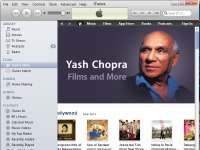
Apple has finally opened the doors to the iTunes Store in India. With this, Indian users can access local and international music, and full-fledged movies as well. Featured artists include names such as A R Rahman, Kishore Kumar, and Lata Mangeshkar among others. A press release suggests that well over 20 million DRM-free songs can be now purchased and downloaded.
For cine buffs, movie titles from major studios such as 20th Century Fox, Sony Pictures Home Entertainment, The Walt Disney Studios, and Warner Bros. Pictures have been made available in HD (720p) as well. You can also choose to rent out titles instead of purchasing them. 720p movies will cost you a maximum of Rs 420 (Rs 120 on rent); other titles are priced at a maximum of Rs 290 (Rs 80 on rent). Individual songs are priced between Rs 7 and Rs 15, and you can download entire albums too.
But that's not all. Apple has also introduced the iTunes Match cloud service, which lets users aggregate their music purchases from outside iTunes to the cloud for easier access. Priced at Rs 1,200 per year, the service lets you sync music on any iOS device.
TAGS: Internet, E-Commerce, Culture, Apple, Kamakshi
Beware Of What You Post: Political Hooligans Are Reading!
Just how far does Section 66A of the IT Act curb your freedom of speech on the internet?
-
Kamakshi S
03rd Dec 2012Pages
Of the many words we associate with the Internet, "freedom" is one of the more obvious ones. That's been changing fast worldwide, with China as probably the best example. But do we Indians, especially those of us who are vocal about our political or religious views, have reason to worry? Does the law actually allow for a citizen to be arrested based on something he/she said online, perhaps casually, perhaps under a nickname? Is it really that easy for political hooligans to bully us and gag us online? We spoke to a legal expert, Advocate Aniket Nikam, to find out what our laws currently allow. If you are the outspoken kind, do read this article in full — it could concern your staying out of jail! First, a bit of background:
Being in a democracy, we have some fundamental rights, one of which is the right to freedom — including freedom of speech and expression. But with great power comes great responsibility, so there is always the danger of getting carried away (or being taken too seriously — but that's a different discussion). This right, too, is and was never absolute. There have always been laws to ensure that the right to freedom does not lead to slander, indecency, and more.
What's more recent, and in mainstream news, is an inclusion under the Information Technology Act – 2000, called Section 66A. The Section was added as recently as in 2008. It is under Section 66A that the Palghar police arrested two girls for a supposedly incendiary Facebook post.
Freedom Of Speech Always Has Limits
While there is national furore surrounding the recent "Facebook arrest," as it were, we must step back and note that the constitutional freedom of speech has never been absolute. Section 499 (defamation) and section 500 (punishment for defamation) of the Indian Penal Code (IPC) have always existed.The chapter of the IPC relating to defamation is considered draconian: It was laid down by the British to curb public uproar in India. But it has survived for more than a century and a half, because it lays down very clear guidelines as to what is considered slanderous and what is not.
In what is a stark contrast and a sad irony, Section 66A (which is just four years old!) of the IT Act is very ambiguous in comparison.
Advocate Aniket Nikam, whose professional credits include having represented the Indian Army as its Chief Counsel before the judicial commission in the Adarsh Society scam, elaborates: "If you read Section 66A, you will realise that it is very vague. There are lot of loopholes in the section itself. Any person can twist it for his own benefit against another's. It lays down a very subjective test, so it would depend on the investigating officer to decide what would amount to a contentious act, or what would hurt religious sentiments.
"It does not lay down the categories or instances where it can be invoked, so it leaves a lot of room for misuse and misapplication — which happened recently in the Palghar case".
The contrast here is between defamation in general and defamation on the Internet. In our country, the rules pertaining to defamation on the Internet leave less room for argument! As Nikam says, "Sections 499 and 500 of the IPC lay down instances and defences: If you said something in good faith or believed something to be true, then it cannot be called an act of defamation. However, it is not so carved out in section 66A: It doesn't specify any exceptions".
Reading Between The Lines
Section 66A, vague as it is, was appended to the IT Act in 2008 — by which time the ways of the Internet should have been understood by our lawmakers. As a result, we have to wonder about the judicial health of the country. Section 84B of the Act, which talks about abetment of offences, is equally vague.This means that a mere Like, Share, or retweet can make you party to a crime.
Those who codified the law, Nikam says, "should have foreseen the repercussions of a vaguely-worded section. It is very unfortunate that our parliamentarians did not envisage the misuse or misapplication of these provisions".
Not For Political Hooligans Alone
Can anybody accuse anyone else of abusing free speech online? Yes. Will the police take action every time? It depends on them.Nikam states, "Under this section, you can lodge a complaint with the police saying that a particular person said something offensive, and ask them to initiate proceedings and take cognizance for it. It is then for the police to decide whether to take action or not. In the Palghar case, there was a lot of political pressure, and the backdrop was such that the police moved to take action."
But what constitutes offensive speech online? There is a guideline regarding this, but it leaves room for subjective judgment. Nikam says that in the Palghar case, the police "thought that whatever was posted by the two girls was of an incendiary nature, and was likely to cause anger. They thought they should initiate action under 66A, but they overreached it. The words used in the statement were not such that it would amount to any kind of anger. If you see the guideline, it says, it should anger a reasonable person, not a person who is hypersensitive".
Punitive Actions: Are They Corrective Or Damaging?
Offences committed under the IT Act are cognizable, meaning that any person booked can be arrested without a warrant. Moreover, there is no scope for a monetary penalty: Prison it'll have to be, for a maximum of three years. In reference to the recent incidents in Palghar, should such a trivial offence attract such heavily punitive actions?Nikam suggests, "Attaching penal consequences to offences is always going to worsen the situation. For instance, if I lodge an FIR against a Mr X, saying he tweeted this and it will affect public harmony, the police can put him behind bars. The only defence available here is to apply for an anticipatory bail, and Mr X can go for squashing on an FIR lodged against him. It may be proved right or wrong in the future, but the stigma will always be attached."
Outside of the IT Act, the law is more reasonable. Nikam says, "Section 499 [which deals with defamation] is different. If something is true, if something is said in good faith, etc., unwanted arrests can be averted".
With the Supreme Court now questioning the legality of the Section, we'll just have to keep watching how many more victims Section 66A will claim — before being fixed for good.
-
News Corner- DRIFE Begins Operations in Namma Bengaluru
- Sevenaire launches ‘NEPTUNE’ – 24W Portable Speaker with RGB LED Lights
- Inbase launches ‘Urban Q1 Pro’ TWS Earbuds with Smart Touch control in India
- Airtel announces Rs 6000 cashback on purchase of smartphones from leading brands
- 78% of Indians are saving to spend during the festive season and 72% will splurge on gadgets & electronics
- 5 Tips For Buying A TV This Festive Season
- Facebook launches its largest creator education program in India
- 5 educational tech toys for young and aspiring engineers
- Mid-range smartphones emerge as customer favourites this festive season, reveals Amazon survey
- COLORFUL Launches Onebot M24A1 AIO PC for Professionals
-
-
## -
-
-
-
-
-
-
-
-
-
-




















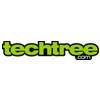





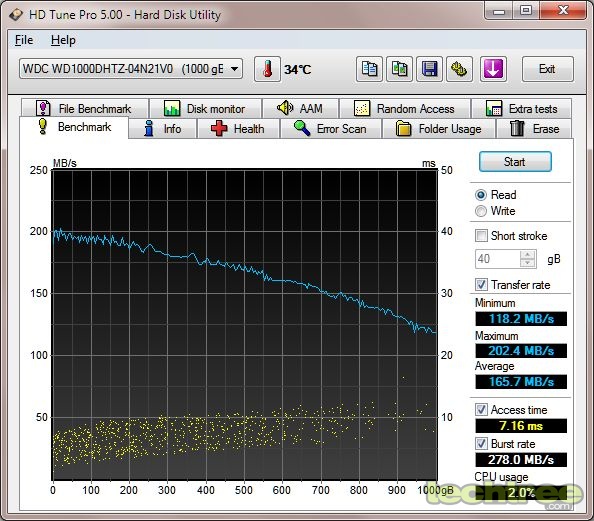










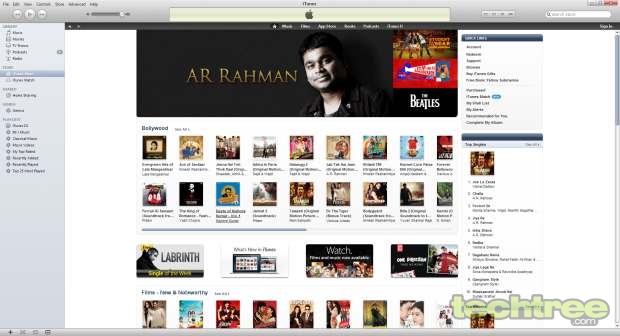
TECHTREE